It recently came to my attention that I hadn’t written a piece dedicated to one of my favorite forms of handgun carry—the pocket holster. I’ve discussed some favorite pocket holster designs, but haven’t written about the practice very much. That’s a shame, because this is one of the most useful ways to carry a snub revolver, and it deserves some attention.
Why Pocket Carry?
Considering all the ways we could carry a gun, why would we want to carry one in our pocket?
For me, the best reason to carry a gun in a pocket is that it’s both discrete and convenient. With a good pocket holster, I can carry my S&W 640 out of view, but still have ready access to it. I find it’s especially useful to carry this way when I have to “dress nice,” with a tucked-in shirt that would prevent me from using my normal belt holster, but it’s also very useful on windy days when I can’t keep a cover garment from lifting and exposing my gun, or pressing against it and printing.
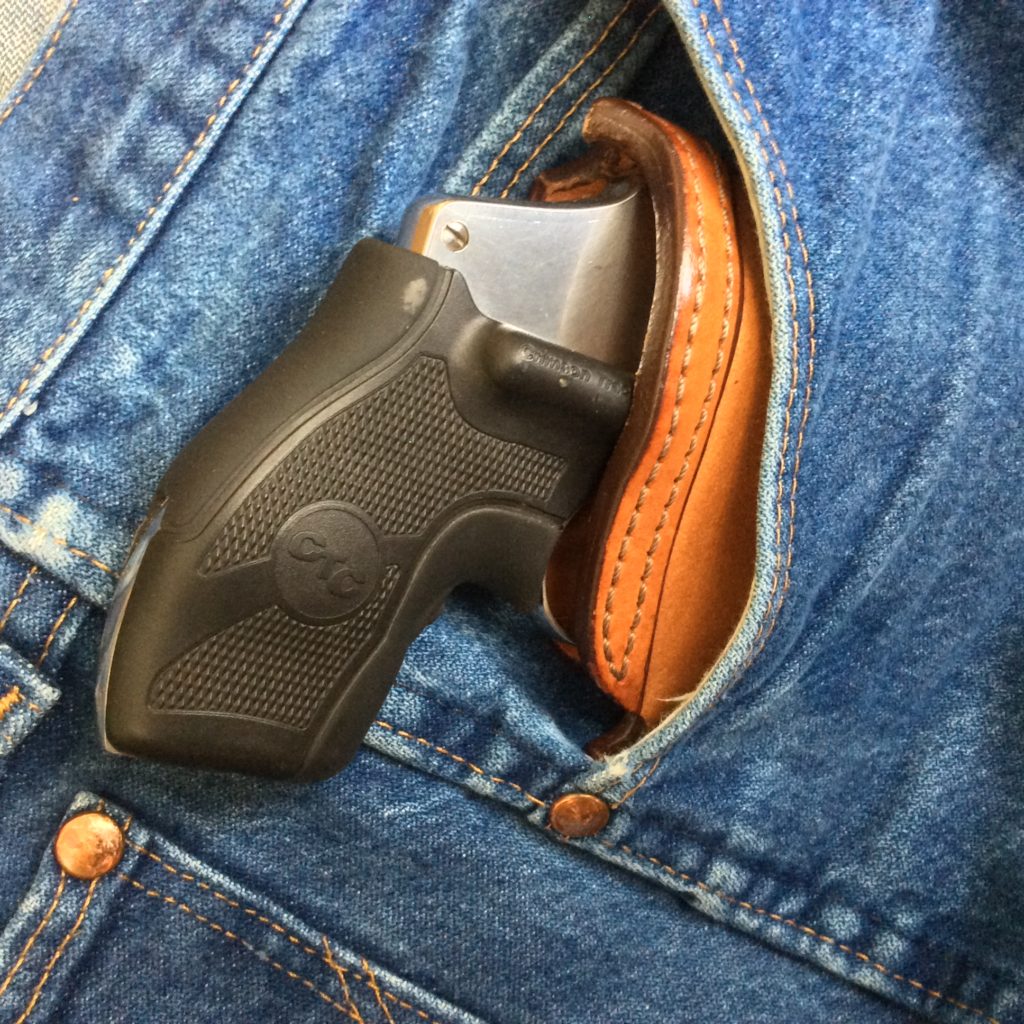
There’s a comfort benefit with pocket carry, too. Sometimes, when my lower back starts to give me a hard time, it can be uncomfortable to carry a heavier gun (and reload) on the belt. Carrying a light snub in the pocket, and a lightweight Speed Strip as my reload, is much friendlier on the body. Similarly, when the temps get hot, and I spend lots of my day overheated and wet, it’s not much fun to carry a gun inside the waistband, up against my skin. Sticking a smaller gun in the pocket can be a lot more comfortable, and it also keeps the gun a little more protected from corrosion.
There’s an aspect of convenience with pocket carry that shouldn’t be overlooked, either. Sometimes you just don’t feel like getting all “geared up,” and it’s a nice option to put a snub in your pocket, and go about your day in “low drag” mode.
Of course, a pocket gun makes a great backup, or second gun, as well.
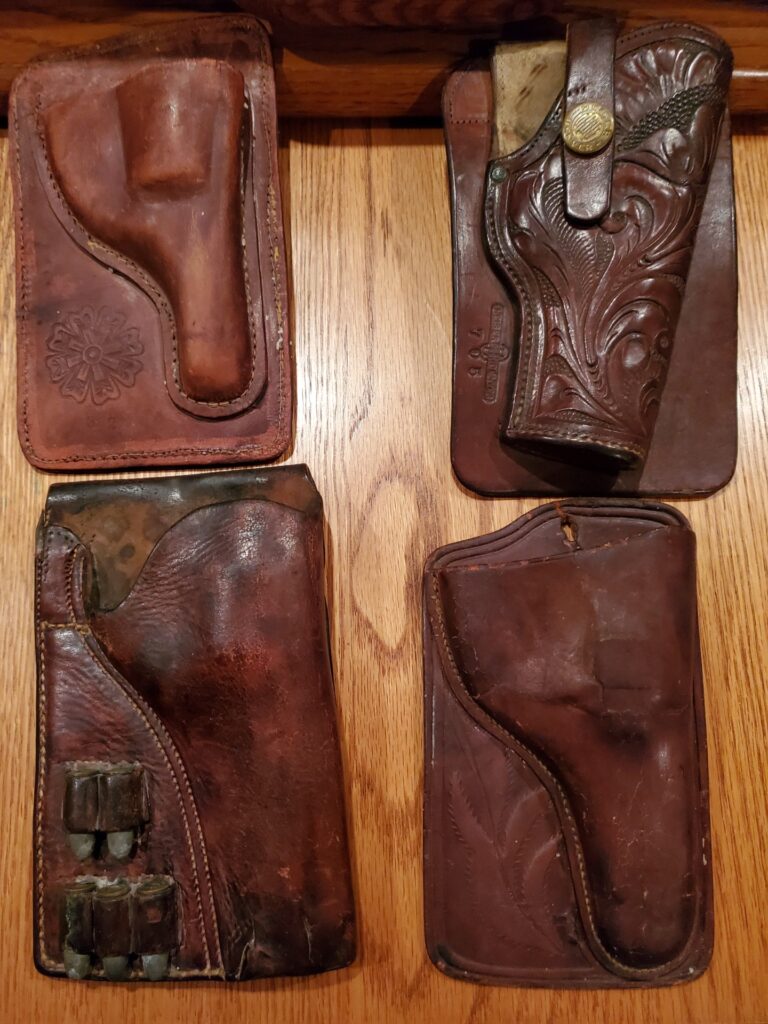
Tactical Advantages
There are tactical advantages to the pocket-carried gun that are important to recognize.
One of the most important is that a pocket-carried gun allows you to be “at grip,” and have the most difficult part of the draw finished, without drawing undue attention to yourself. The process of getting through cover garments to establish a good firing grip on the gun is the most error-prone part of the concealed carry draw, and the most time consuming as well, so it’s a huge advantage that pocket carry allows you to “cheat” this process by getting a grip before it becomes necessary. If you sense that you might need to draw your gun sometime in the near future, you can complete the most difficult part of the draw and establish your firing grip on the gun, while giving the appearance of just another harmless guy with his hand in his pocket.
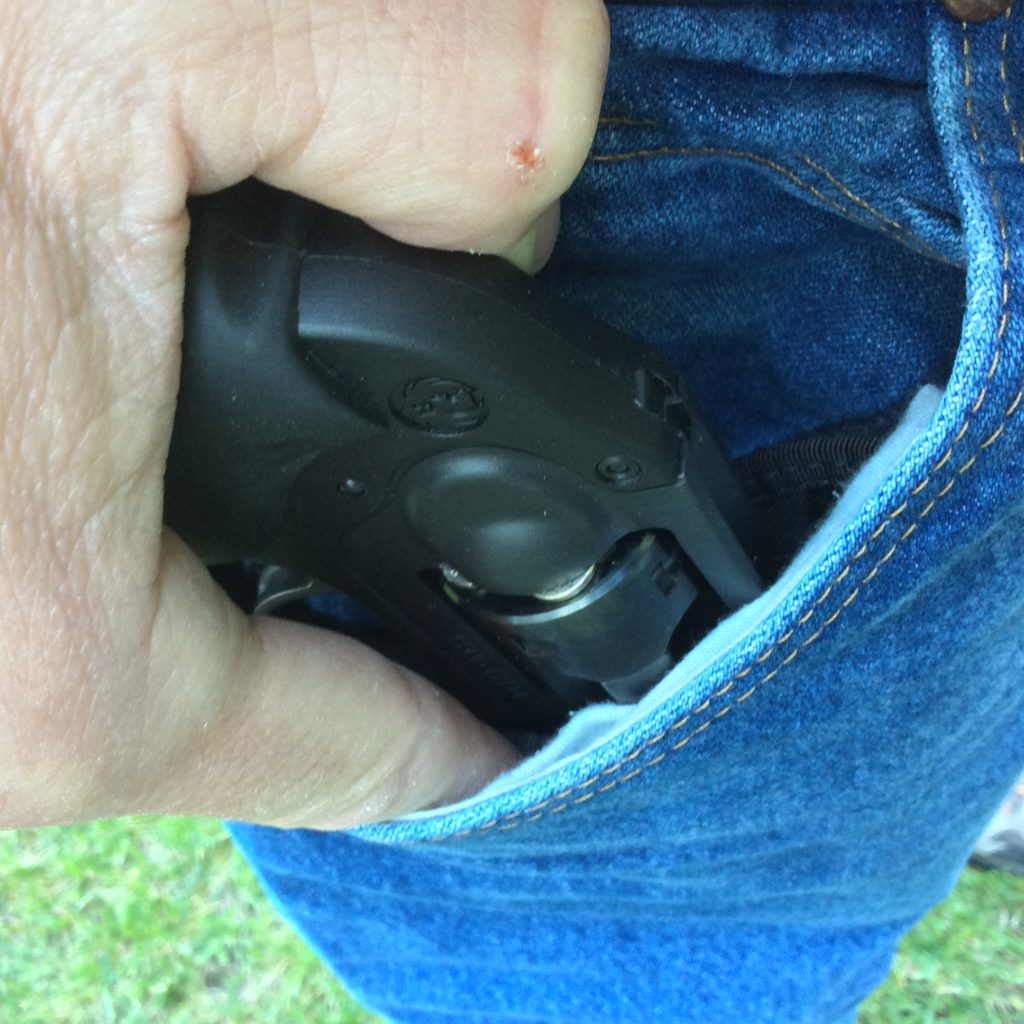
This gives you a speed advantage in your presentation, but it also allows you to deal with ambiguity much better. If you have to deal with someone who might be a threat, or might become a threat, but you’re not sure about him right now, it’s really nice to be more than halfway through your draw without looking like it. If the situation turns out to be nothing, then nobody is the wiser. However, if the person turns out to be a lethal threat, pocket carry might allow you to “catch up” a bit on your reactionary deficit, by making your presentation faster and more reliable.
There’s a related benefit that’s worth consideration too. Because the initial stage of drawing a gun from a pocket doesn’t actually look like a draw, it might allow you to get ahead of your opponent’s decision-making process. Consider a situation where your attacker is threatening you with lethal force, and has directed you to retrieve and surrender your valuables. It would be easy to feign compliance with this demand while you’re reaching for your gun if it was carried in a pocket, because the motion eliminates some of the tell-tale physical cues that precede a draw from a holster on the waistline, which would betray your intent. The split-second advantage that comes from a surreptitious draw could make all the difference in winning your fight.
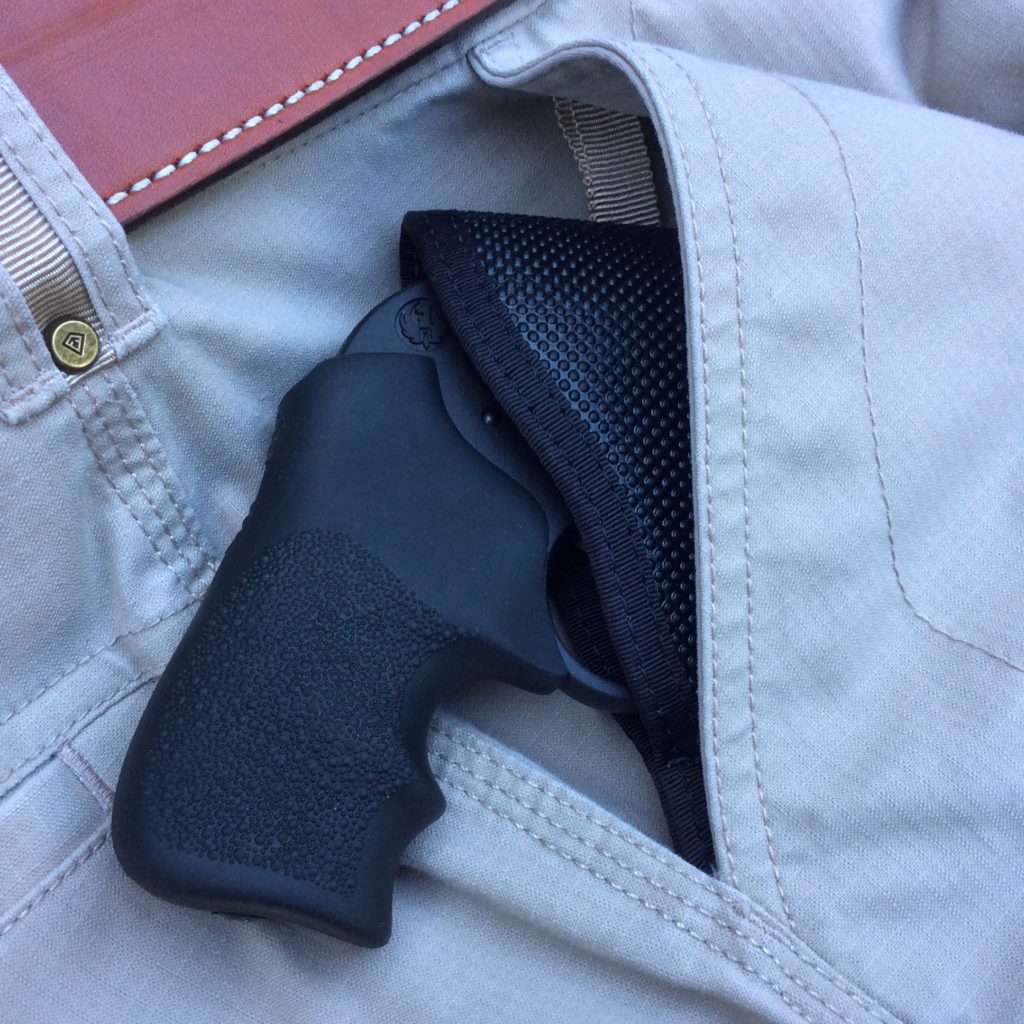
Pocket carry can also increase your options and improve your access to a gun, especially if you are carrying a second, or backup gun in your pocket. In the wintertime, for example, it can be hard to get through multiple layers of clothing to get to your belt-carried gun, but a small gun can be carried in the outside pocket of a coat, and give you a more readily accessible weapon. A similar situation may apply when you’re seat-belted into a car—drawing a gun from an external jacket pocket might be easier than getting to the gun hidden underneath the jacket, and underneath the seat belt.
There are some privacy advantages to carrying in a pocket, too, because it’s easier to shield your gun from people that you don’t want to tip off about your armed status. If you’ll be in a crowd of people, standing in a line, or even in a situation where you might be greeting and hugging people, the pocket-carried gun is easier to keep away from eyes, hands, and inadvertent bumps. If someone does bang into it, it’s easy to dismiss it as your phone or wallet—people are used to carrying bulky things in a pocket, but a hard bump on your belt line, particularly behind the hip, is harder to explain away.
Tactical Disadvantages
We have to recognize that pocket carry also suffers from some disadvantages, as well.
The biggest disadvantage of pocket carry is that it places practical limits on the size of gun that you can carry. I suppose there are some pockets, like the thigh pockets on some cargo pants, which can accommodate a large gun, but for most practical purposes, you’re going to be limited to using a small frame gun, with a limited capacity.

That small gun will have to be free of controls, parts, and features that will increase the potential for the gun to snag on its way out of the pocket. This eliminates some kinds of guns from serious consideration, in my experience. For example, most autopistols don’t draw very well from a pocket, because the rear of the slide is prone to snagging on the way out. Similarly, guns with spurred external hammers, beavertails, and high-profile sights can also be troublesome to present from the pocket.
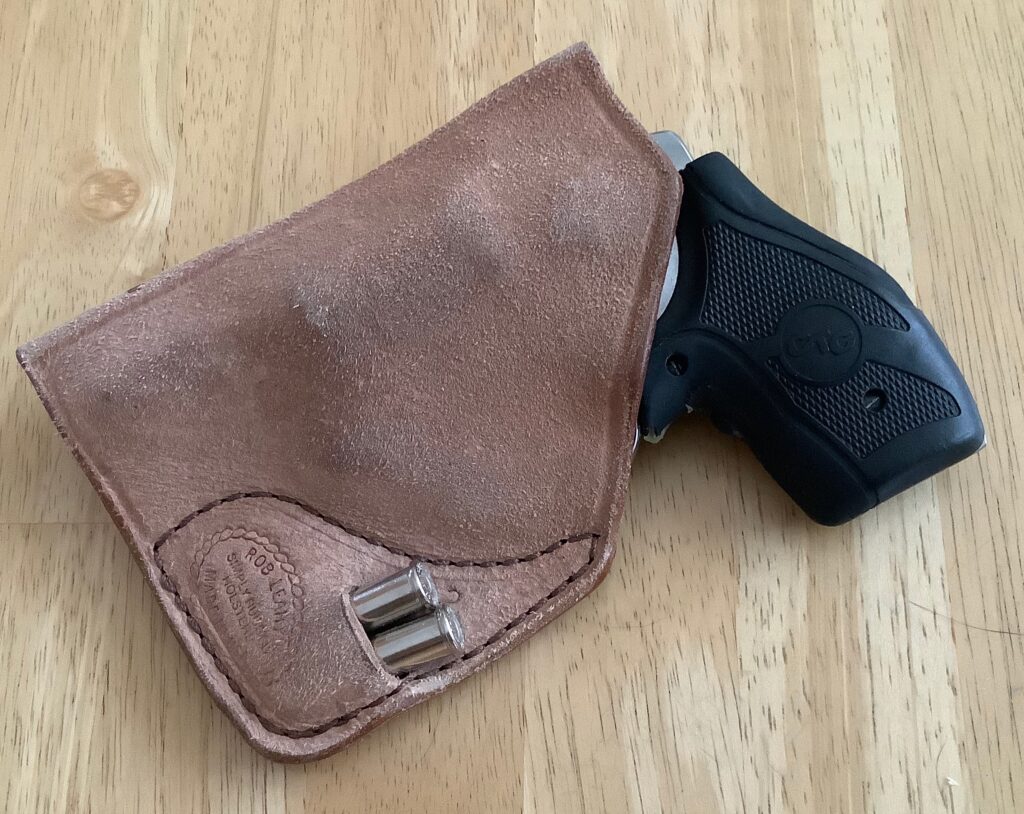
Pocket carry is often incompatible with autopistols that have prominent magazine buttons on the side of the frame, or even on the heel of the gun. It’s easy for these buttons to be inadvertently pushed while the gun rides in the pocket during normal daily activities, causing the magazine to be displaced. This may disable the gun entirely, or turn it into a single-shot weapon.
A similar situation exists for autos that have manual safeties. It’s easy for these to be disengaged if they were on, or engaged if they were off, without your knowledge as the gun bounces around in the pocket–even with a holster. Either situation could create a big hazard for you.
For reasons like these, I think the hammerless snub is the King of pocket carry. But even the snub has its drawbacks and limitations, because nothing is perfect. One of the greatest snub limitations has to do with grips. The oversized, slightly tacky, rubber grips that so many shooters prefer to attenuate snub recoil and improve control can often be incompatible with pocket carry. In some pockets, you’ll have to go with a more compact, less “sticky” grip, to make it all work. They may not be as comfortable for shooting, but they won’t complicate or foul the pocket draw like the bigger ones can.
Another Issue
Another issue with pocket carry is that it can be difficult to access the gun when you’re seated, or when you’re walking or running, depending on the pocket in use. For instance, when I pocket carry my S&W 640 in the front pocket of my jeans, I can’t get to it when I’m sitting, unless I’m able to straighten out my leg. Even then, it can be difficult to retrieve the gun (which is why I’m also a fan of ankle carry—we’ll talk about that soon, in these pages).
The draw stroke from a pocket is also awkward when you’re in motion, and you’re often better off just focusing on movement first, and drawing your gun after you get to cover, as any attempt to both draw and run will just make you inefficient at both. Drawing from a rear pocket is easier than drawing from a front or leg pocket when you’re in motion, but it’s still not as easy as accessing a weapon on your belt while your feet are moving.
And One More Thing
A significant challenge with pocket carry is that you can quickly run out of space to put all your stuff! When you carry your gun in a pocket, you don’t want put anything else in that pocket which may interfere with the draw or foul the gun’s controls, so you’ll have to find another place to put the things that you normally carry there.1
With all the stuff we carry around these days—keys, phones, wallets, handkerchiefs, combs, knives, OC spray, flashlights, first aid supplies, sunglasses, spare ammo, the kitchen sink—you can start to run out of space pretty quick when you’re down a pocket . . . especially if the dress code prevents you from wearing cargo pants! You might have to reorganize, or suck it up and carry a little less stuff, if you’re going to pocket carry. It’s all part of the tradeoff, as there’s no free lunch.
The Guns
I mentioned it previously, but the real superstar gun of pocket carry is the hammerless snub.
The hammerless snub is the right size, weight and shape to make it a good pocket carry gun. In reasonable clothing, you can carry one of these without looking like you have a tumor on your leg, but still have an adequate weapon for defense.
The rounded surfaces and profile of the snub revolver make it “blend” better in a pocket than the squared lines and pointy corners of an auto. These same curves also make the snub revolver come out of the pocket smoothly, without extra drag or snags.
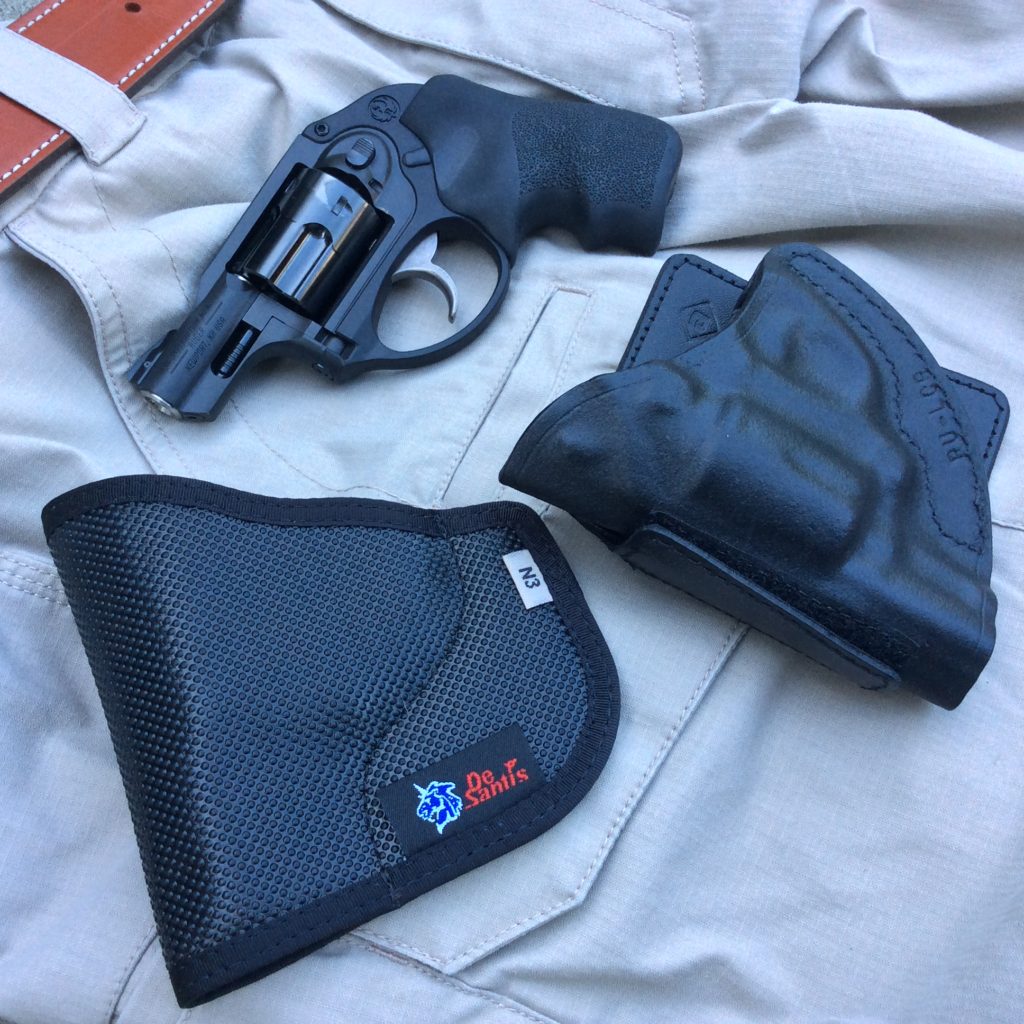
A snub revolver with an external hammer spur can be made to work for pocket carry, with a modification to your grip that places the tip of the thumb on top of the hammer spur, to create a “hammer shroud” of sorts, and a similar method can be used to help smooth the profile of an auto, by placing the thumb on top of the rear of the slide, but these workarounds aren’t quite as effective as carrying a hammerless snub, in my experience. They also complicate getting a good firing grip on the gun, because you have to make adjustments after the gun comes out of the holster and pocket, which is a little late in the draw to be doing this.
The hammerless snub also benefits from being resistant to the lint and other debris that normally finds its way into pockets. A true “hammerless” gun (not just a spurless, or shrouded hammer revolver, like the classic Bodyguard), with an enclosed frame, will admit less garbage into the action which could gum up the works. Although most service-sized autos are very reliable these days, the smaller autos which are best suited for pocket carry tend to operate more on the margins of reliability, and it’s been my experience that they can’t match the reliability of the hammerless snub—in any normal conditions, but particularly in an environment where crud might build up on them. I’ve actually seen little balls of lint completely tie up an autopistol that a hammerless snub would just shrug off.
It’s easier to obtain a firing grip on the butt of a revolver that’s carried in your pocket than an auto’s grip, because the thicker cylinder naturally creates space for your hand to get between your body and the grip of the gun. By comparison, an auto, with its flat sides, will lay flat against your body, and will require you to wedge your hand into the space between your body and the pistol, to obtain a firing grip. This can slow and foul the presentation of your gun from the pocket.
Why Use a Pocket Holster?
Although some people might be tempted to carry a gun in their pocket without a holster, we think it’s a bad practice, and encourage the use of a pocket holster for the following reasons:
-
-
- It Protects the Gun. A good pocket holster protects the gun from damage, corrosion, and foreign debris. Your gun will get plenty sweaty and dirty inside your pocket, even if you do use a holster, but without a holster’s protection, it will really get trashed;
-
-
-
- It Helps with Weapon Retention. A good pocket holster will help to keep the gun from falling out of your pocket during physical activity. Whether you’re sitting, running, or fighting off an attacker, the holster will help to keep the gun where it belongs;
-
-
-
- It Enhances Safety. A good pocket holster will cover the trigger guard and prevent the trigger from being pulled—either accidentally or intentionally–while the gun is still in the pocket. You might think your DAO revolver trigger is heavy enough that you don’t need to worry about covering it up, but you’d be wrong! Stress, inattention, or that bastard Murphy can all promote a deadly mistake, and a covered trigger guard helps to mitigate the risk;
-
-
-
- It Facilitates a Good Grip. A good pocket holster will keep the gun consistently oriented for a clean draw, and allow you to rapidly obtain a full firing grip on the gun while it’s still in the pocket. Without a holster, the gun will usually rotate or flip in an unpredictable manner, which will require you to sort things out before you can grip and draw the gun. This increases the risk of an error and failed draw, and also takes valuable time that you won’t have in an emergency;
-
-
-
- It Facilitates a Smooth Draw. A good holster will help to properly guide your gun out of the pocket in a way that it won’t snag on the way out, and interfere with your presentation;
-
-
-
- It Promotes Concealment. Good pocket holsters promote concealment by breaking up the outline of the gun, and evenly distributing its weight. Guns carried loose in pockets usually print very badly, and sag away from the body, instead of blending into its contours;
-
-
-
- It Enhances Comfort. A good holster makes it much more comfortable to carry a gun in the pocket, by evenly supporting the weight, and preventing hard corners and edges from digging into your leg.
-
Selecting a Holster
The following considerations must be taken into account when you’re selecting a holster for pocket carry:
-
-
- Materials. Leather, fabric, and polymer are the primary materials for making pocket holsters, and each has their own Pros and Cons.
-
Leather is durable, comfortable, and holds its shape well when the gun is withdrawn. It can be tightly boned for excellent weapon retention. If the rough side is facing out, it can help to anchor the holster in the pocket and prevent you from drawing it with the gun. On the downside, a leather holster may require some break-in time to be comfortable and stop squeaking, and it will also soak up your sweat, so it’s not safe to store your gun in the holster—take it out of the holster and let things breathe and dry out, at the end of the day (a good idea for all pocket holsters, but especially for leather).
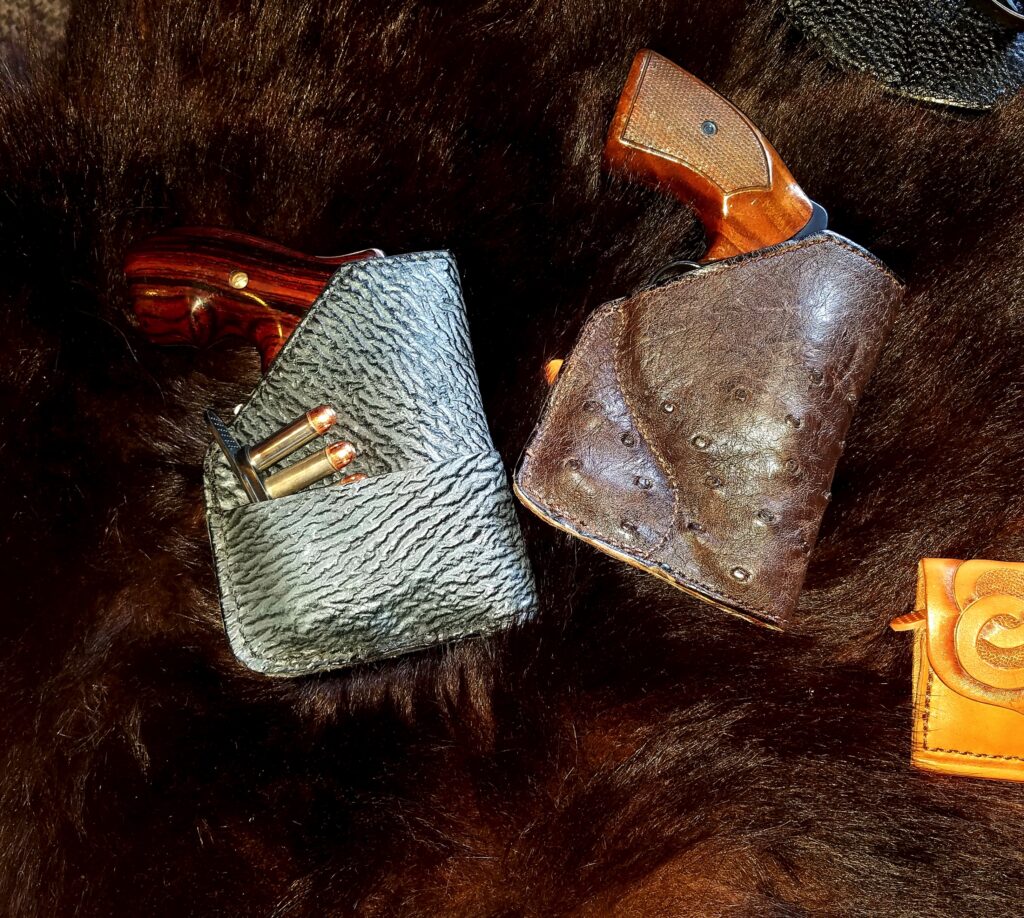
Fabric holsters (made from nylon, usually) are generally softer and more pliable than leather, so they don’t require much break-in to conform and be comfortable. They are lightweight, easier to clean than leather, and do a better job of repelling moisture than leather. They often incorporate a rubberized or “grippy” texture on the outside, to anchor them in the pocket, and are usually the most affordable option to choose from. On the downside, fabric holsters tend to be less durable, and their pockets are usually not tightly molded to the shape of the gun, so their fit is usually looser than a leather or polymer holster’s fit. This sloppiness, combined with the reduced friction of fabric compared to leather, can lead to a smooth draw, but can also decrease weapon retention. Many fabric holsters also collapse when the gun is withdrawn, and do not hold their shape very well, even if the holster mouth is reinforced with a band. Lastly, some fabric holsters can be more bulky than leather ones, because they’re constructed of multiple layers of material. That extra girth may not be noticeable in looser-fitting clothes, but will make the “bump” in your pocket more pronounced in tighter fitting pants, sacrificing some concealment.
Polymer holsters (sometimes made from shaped and formed materials, like Kydex, but sometimes injection-molded) frequently offer the tight fit and durability of a leather holster, with the water resistance, light weight, and ease of maintenance of a fabric holster. They retain their shape when the gun is withdrawn and usually cost less than leather. On the flipside, they don’t “breathe” as well as leather or nylon, and can be more uncomfortable to wear when you are hot and sweaty. They’re usually rigid, as well, which can make them uncomfortable to wear at times, because they don’t conform to your body (over time, your leather holster will take on a bit of a curve, as it adapts to the contours of your leg, but don’t expect the same from most polymer holsters). Lastly, they sometimes make a popping, clicking, or scratching noise when the gun is drawn, which can betray a surreptitious draw. If you choose a polymer holster, pay special attention to the edges, to make sure they have been sanded smooth, for comfort;
-
-
- Molding and Retention. I’ve talked around it a bit already, but it’s important to note that the gun should fit relatively tight in the holster’s pouch, which should be shaped for it.2 A pouch that is specifically molded or boned for the gun will do a better job of keeping it in place, which is a good thing for security and for consistency in your draw;
-
-
-
- Pocket Size and Shape. You’ll find there’s a variety of pocket shapes and sizes in your wardrobe, and it may be tough for one holster to fit all of them well. Some pockets are wider than others, and some are deeper. Some are square at the bottom, some are rounded, and some are tapered. You may have to buy a variety of pocket holsters to work in these disparate spaces. A pocket holster with a base that is too narrow or rounded will allow the gun to tip in a wider, squared pocket, just as a pocket holster with a wide skirt or square bottom may prevent you from getting it deep enough into a narrow or rounded pocket. Evaluate your most likely clothing choices and pocket shapes before you select a pocket holster, to ensure it will fit and do the job well;3
-
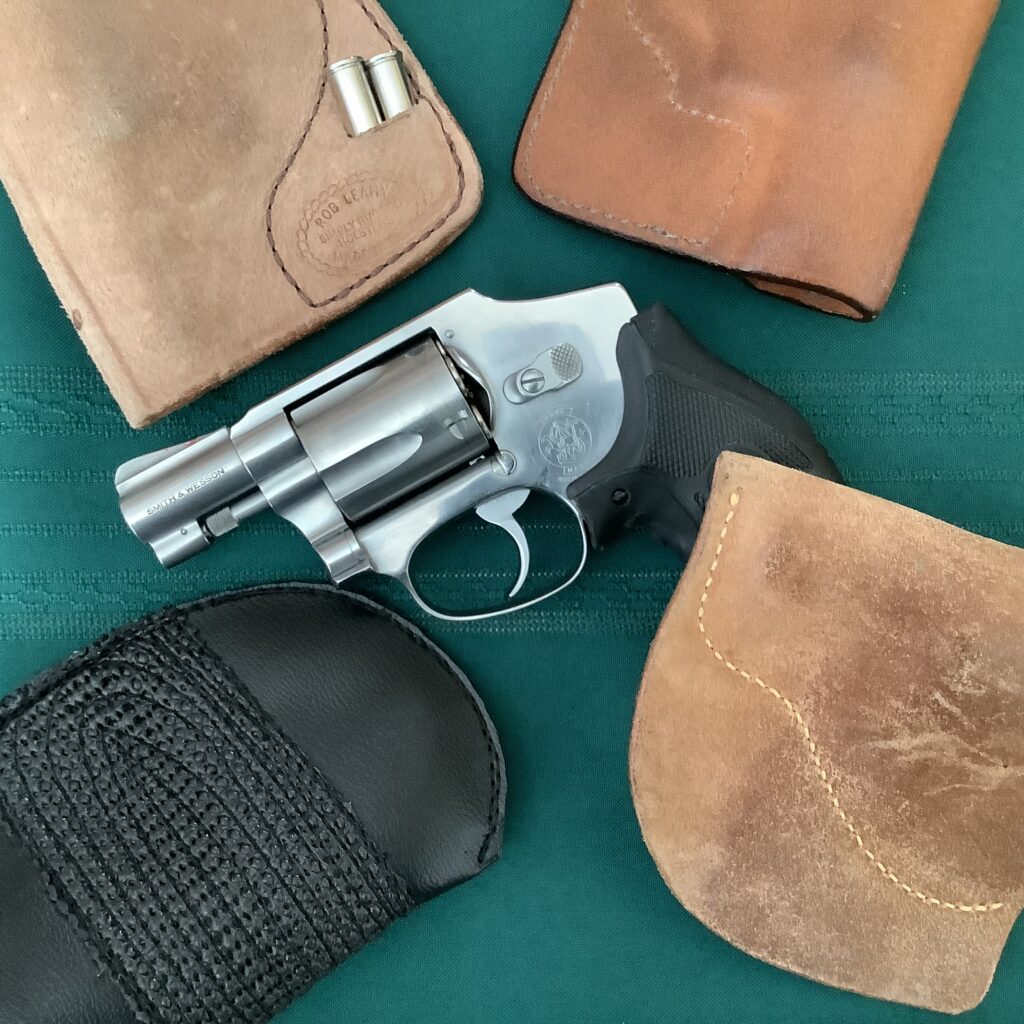
-
-
- Full Firing Grip. Regardless of which holster you choose, make sure you can obtain a full firing grip on the gun while it’s resting in the holster. You don’t want to have to lift the gun out of the holster before you can obtain a good grip on it. This latter situation can occur when the holster’s pouch is sloppy, and is a bad fit for the gun—the gun will sink deeper into the pouch than desired, and reduce the clearance around the grip. This is more common on fabric holsters that are built to accommodate a number of different guns, rather than a specific gun;
-
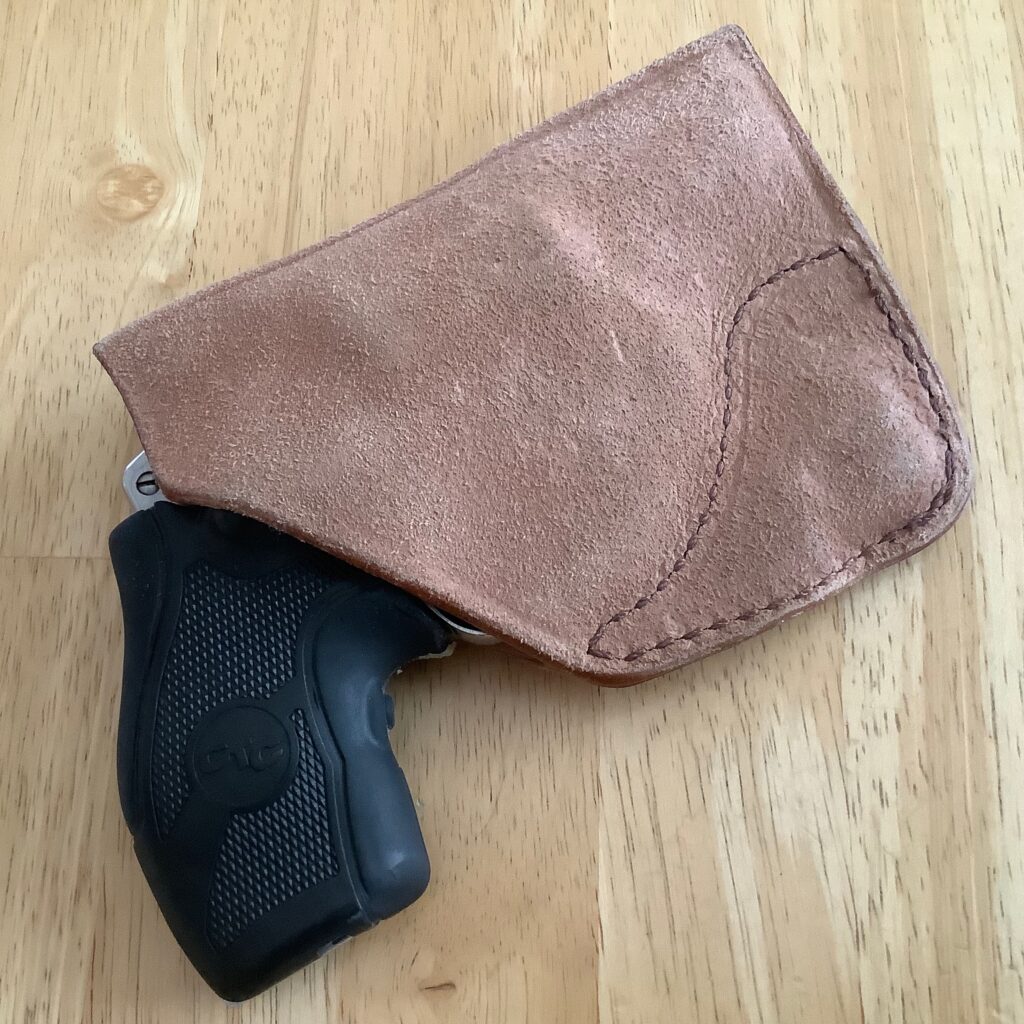
-
-
- Trigger Guard Coverage. You want your pocket holster to completely cover and protect the trigger for safety, and to reduce fouling. ‘Nuff said;
-
-
-
- Ambidextrous Use. There’s an advantage to being able to carry your gun on either side of your body, and some holsters are designed to facilitate that (usually the fabric or polymer ones, less frequently the leather ones). Consider this feature if you might need to carry on either your strong or weak side, and don’t want to buy a pair of Left and Right side holsters;
-
-
-
- Printing. Some holster designs are better than others at reducing printing. Part of this is the shape and thickness of the holster, and part of it is how the holster fits and rides in the pocket. Some holsters, like the ones made by Kramer Leather, actually incorporate a face plate that’s designed to create a square-looking profile in the pocket, to disguise the gun as a wallet or phone. This makes the holster bulkier than it needs to be, which normally wouldn’t be a plus, but in this case, the printing it causes is part of the camouflage. Other holsters, like the DeSantis Super Fly, incorporate a flap or shield to mask the outline of the gun. Again, the extra material makes the holster bulkier than it needs to be, but in the right pocket, it may enhance concealment. While you might find the magic combination of holster and pants style/fit that makes the gun “disappear,” there’s often no way to avoid printing with a pocket holster, but the goal is to make the visible “bump” look like it reasonably belongs there, and to make it look like something other than a gun. The right holster, tailored for the pocket and pants selection, can do that;
-
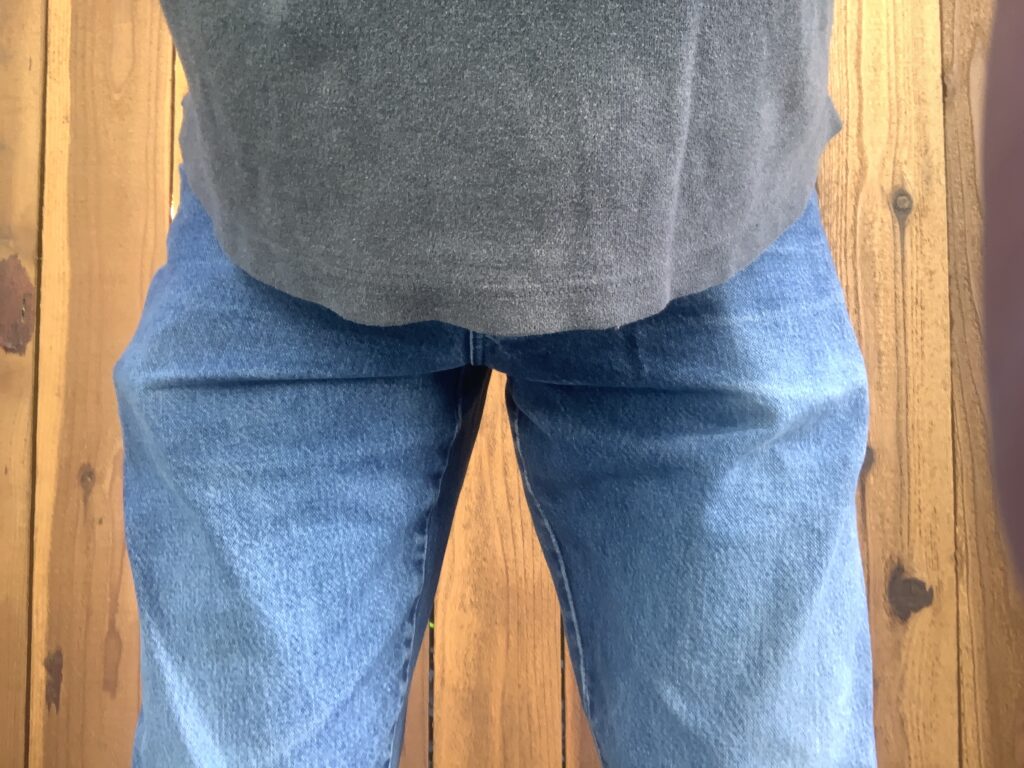
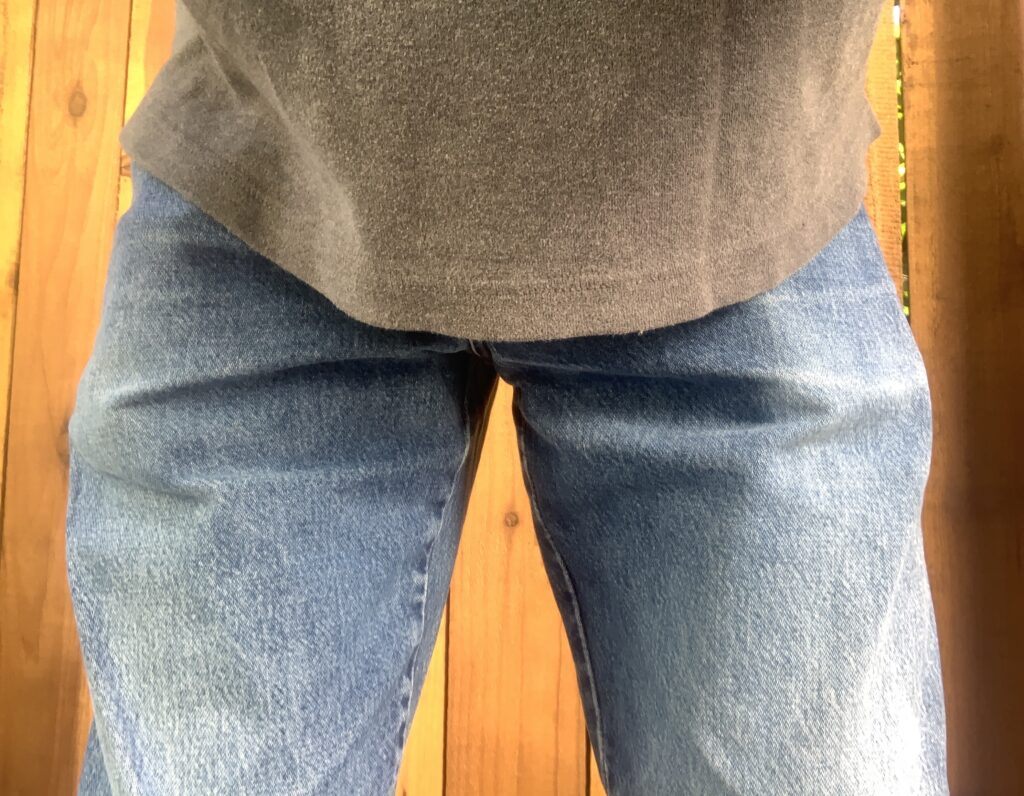
-
-
- Stays Open. Some pocket holsters are designed to retain their shape when the gun is withdrawn, and I think this is an important feature. If the holster stays open, you can easily return your gun to the holster without removing the holster from your pocket, which might be necessary if your support hand is occupied with some other task. It’s far better for the gun to go back into the holster than to just get stuffed loose into a pocket or waistband.
-
A quick note about that: In normal circumstances, we discourage holstering with the holster still in the pocket. The holster should be removed from the pocket first, then the gun holstered, before the whole package is returned to the pocket. It’s a good general practice, especially for any kind of administrative holstering, but I do recognize that stressful, dynamic situations may require us to holster with just one hand, so I like a holster that stays open, to support that. Besides, a holster that stays open is also easier to use in the normal holstering procedure, which occurs outside the pocket. More on this later;
-
-
- Stays in the Pocket. The last thing you want is to draw the holster out of the pocket with your gun. You want the gun to shed the holster as part of your presentation, so it doesn’t prevent you from firing the gun immediately. To accomplish this, most holsters are designed with a hook or a wide skirt that will bind on the mouth of the pocket and leave the holster in place, as the gun is withdrawn. Some holsters are also built with a rough-out leather surface, or a rubberized texture that will aid the holster in gripping the pocket lining, to keep it in place. This is an area where the fit of the holster in the pocket is important, too. A narrowly-built holster may not strip off the gun during the presentation from a pocket with a wide lining or mouth, so matching the holster to the pocket dimensions is an important part of making sure you don’t draw a holstered gun.
-
The Pocket Draw
The draw from the pocket mirrors what you’re used to from your normal draw from the belt line. The gun must be gripped, lifted clear of the holster, oriented towards the target, then extended to the target.

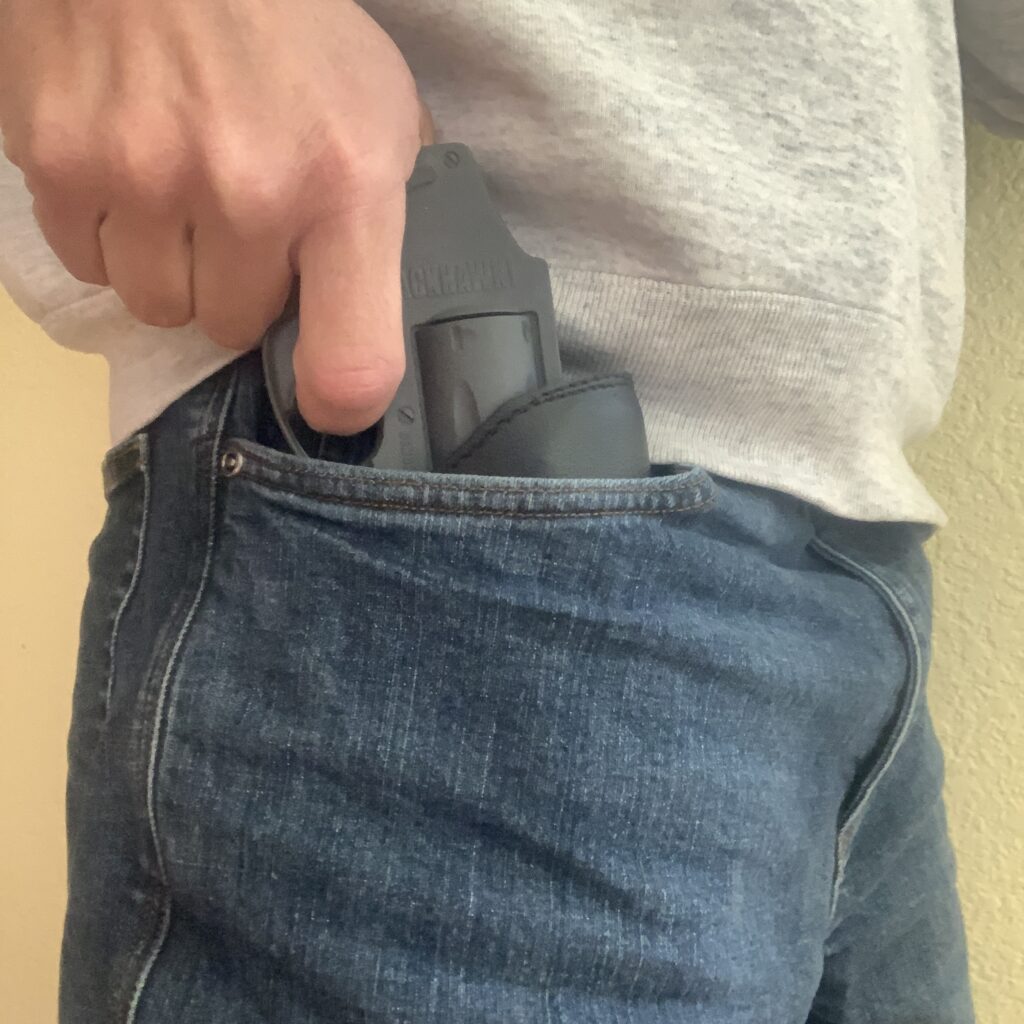
We’ve talked before about the necessity to obtain a good firing grip on the gun, while it’s still in the holster. One issue with the pocket draw, is that some pockets don’t give you much room to get a good grip, because the lining isn’t roomy enough for you to make a fist, or the mouth of the pocket isn’t big enough for your closed fist to pass through. The best correction here is to find clothing with a bigger pocket/mouth, so you don’t have to sacrifice your grip. However, if you’re stuck with a particular setup, or if you’re a hipster who’s hopelessly addicted to skinny jeans, you might have to lift the gun out of the pocket with your fingertips, and delay getting your firing grip until the butt of the weapon is clear of the pocket. This isn’t ideal, but you’ll have to accept it and do the best you can with what you’ve got.
Lifting the gun clear of the holster presents its own challenges, in pocket carry. One is that you may have to alter your normal draw stroke to accommodate the angle of the pocket. Some pockets are accessed through the top (think of a front pocket in a pair of jeans), and this may work well with your normal up-and-forward presentation that you’re accustomed to, but a pocket that is accessed from the rear (think of a front pocket in a pair of dress pants) may require you to change your draw stroke completely. If you try to raise the gun up and forward from this kind of pocket, it might get hung up inside the pocket. Instead, you may have to remove the gun towards the rear, to clear the holster and pocket mouth, then change direction and move it forward towards the target.
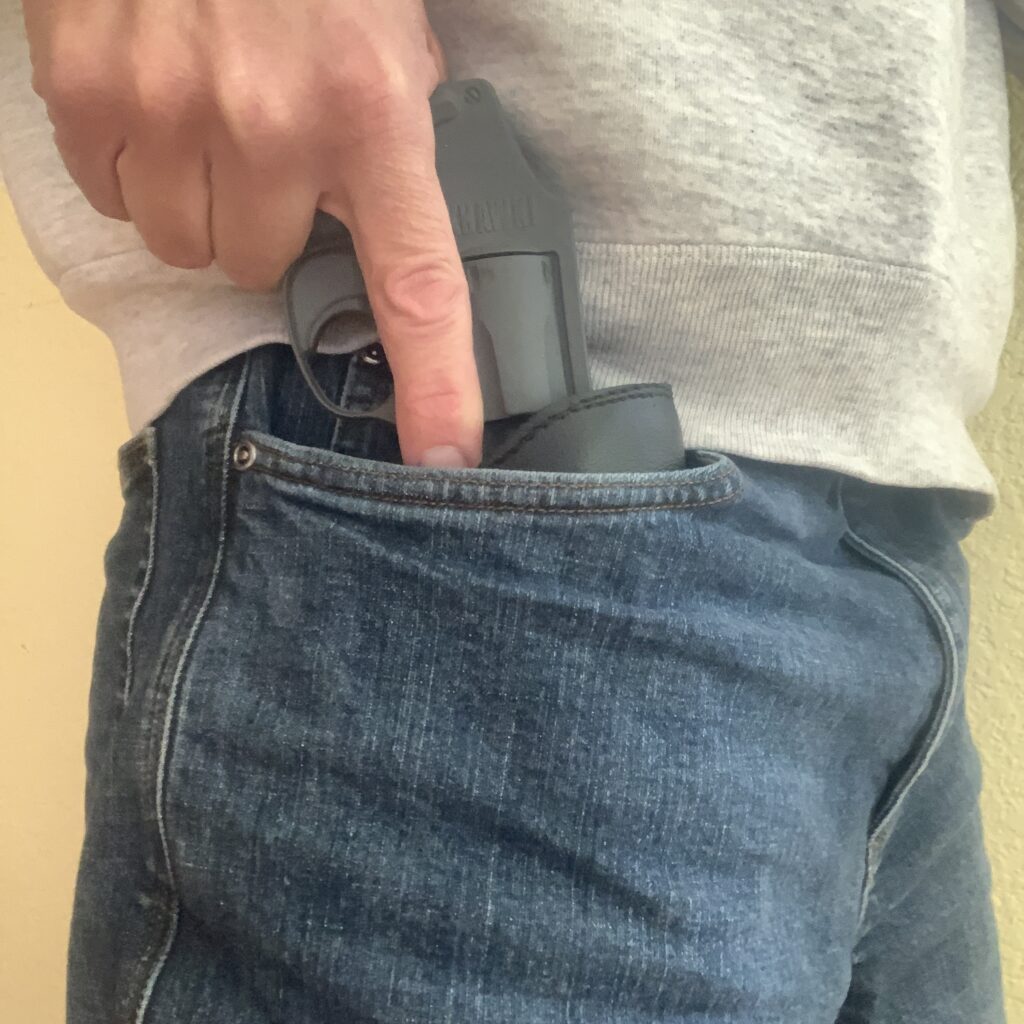
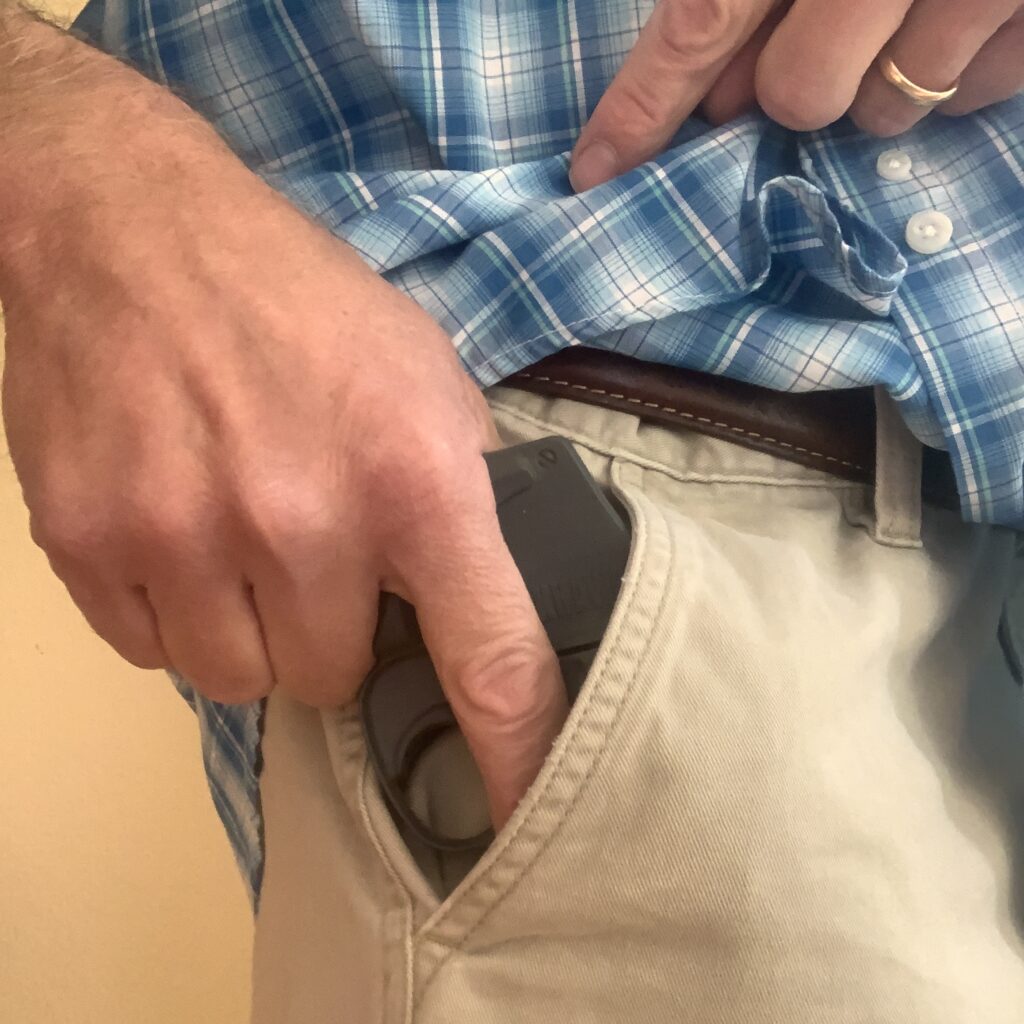
Another consideration in this phase of the draw is ensuring the holster will be shed from the gun as you present it. As we previously discussed, some holsters are built with a hook or a wide skirt that’s intended to catch and drag on the pocket mouth, to help keep the holster in place. These usually work pretty well, but sometimes (especially in roomier pockets) these drag devices will “miss” the edge of the pocket mouth, and allow the whole shebang to come out as one.
That’s not a good thing.
To help remedy this, I’ve found it can be helpful to adjust your draw stroke so that you incorporate a “wiping” motion into the draw. For example, if the hook on your pocket holster is on the leading edge of the holster, you can act like you’re trying to drag the front sight of your gun against the forward edge of the pocket mouth when you lift the gun out of the pocket. Just imagine trying to wipe the front sight clean on the edge of your pocket on the way out, and you’ll help to ensure the forward hook on the holster engages.
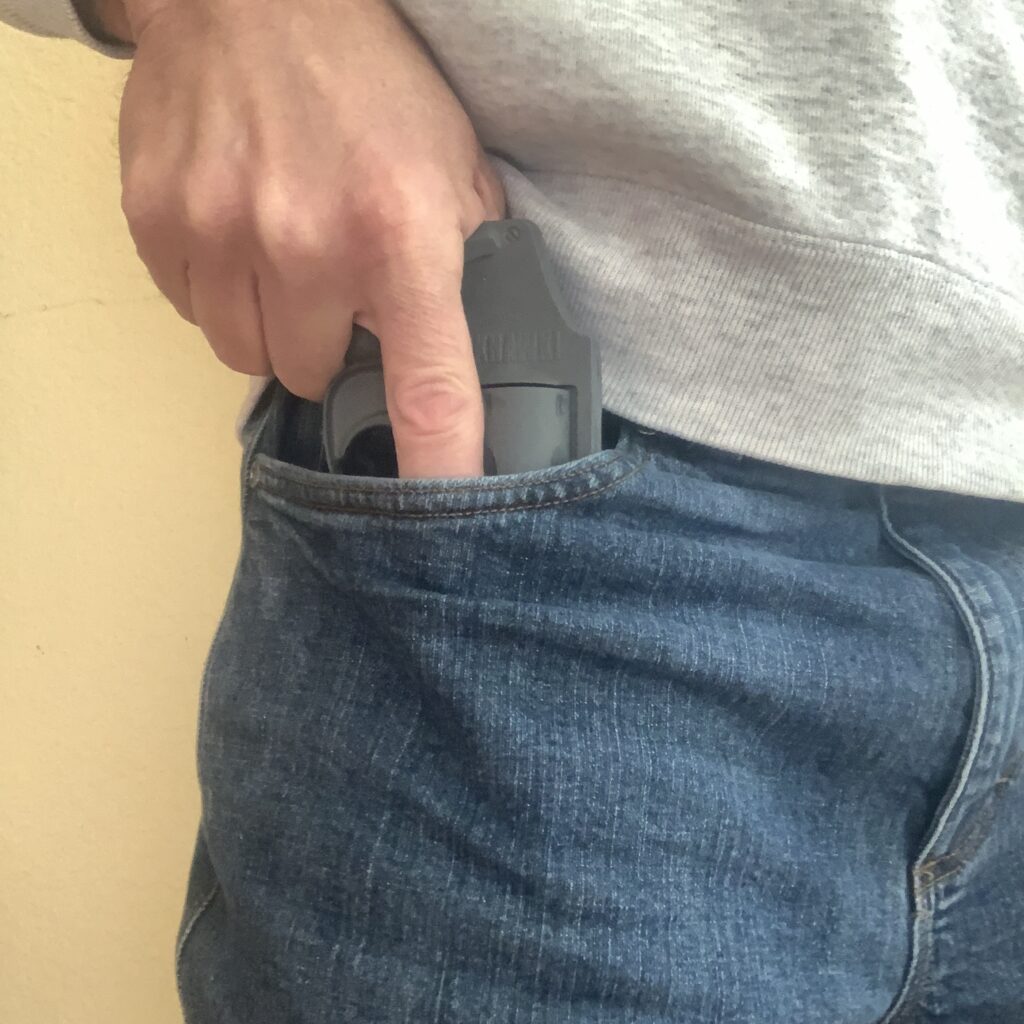
The same can be done if your pocket holster has a hook or a wide skirt at the rear. Imagine trying to rub the bottom of the trigger guard against the trailing edge of your pocket mouth as the gun is lifted out of the pocket, and you’ll help to wipe the holster right off the gun as it comes out.
Once the gun is clear of the pocket, you’ll want to immediately point the muzzle towards the threat, in a manner that you don’t track it across your own body parts on the way to the target. Don’t sweep your leg or your support hand with the muzzle of your gun as you bring it to bear on the target. This can be especially tricky if you’re drawing a gun from a pocket that you had to access from the rear, because the gun could wind up behind your hip or leg. It could also be tricky if you had to draw from a pants pocket while seated, so think it through, and practice some dry-reps with a triple-checked, unloaded gun.
Regardless of how you get the gun out of the pocket, you must never put your finger on the trigger until the gun is oriented towards the target. Keep the trigger finger straight as you establish your firing grip, lift the pistol out of the holster, and index it on the target, to keep from shooting yourself or an innocent. You don’t want to do the enemy’s job for him, after all.
Holstering the Pocket Gun
We’ve already touched on this, but it’s recommended that you remove the holster from your pocket, safely holster your gun (don’t muzzle your own hand as you do this—it’s best to think about putting the holster on the gun, rather than putting the gun into the holster, to avoid pointing it at yourself), then put the whole package back into your pocket when it’s time to put the gun away.
There may be tactical situations that will require you to put the gun away quickly with one hand, which may not allow you to follow the above procedure. If so, you’ll have to do your best to observe Rules Two and Three (muzzle and trigger awareness) as you put the gun away in your pocket.
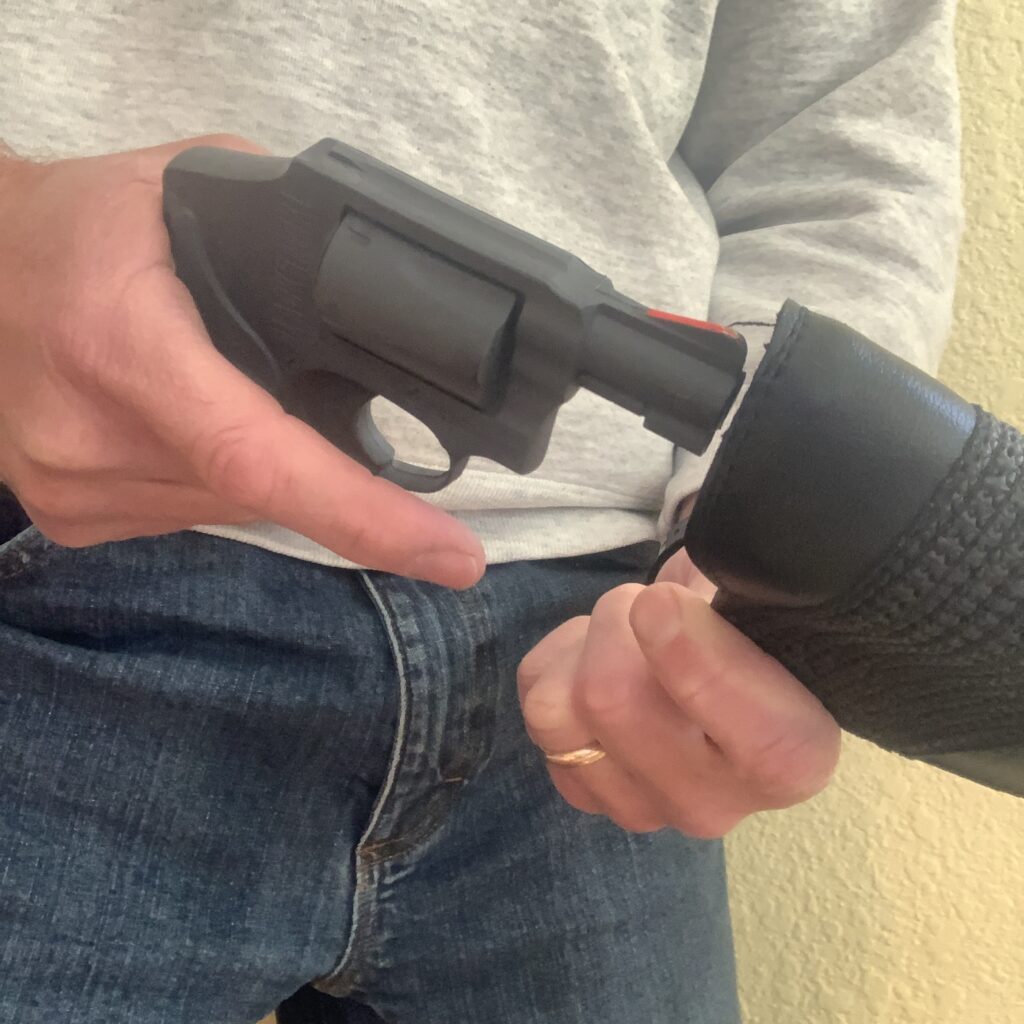
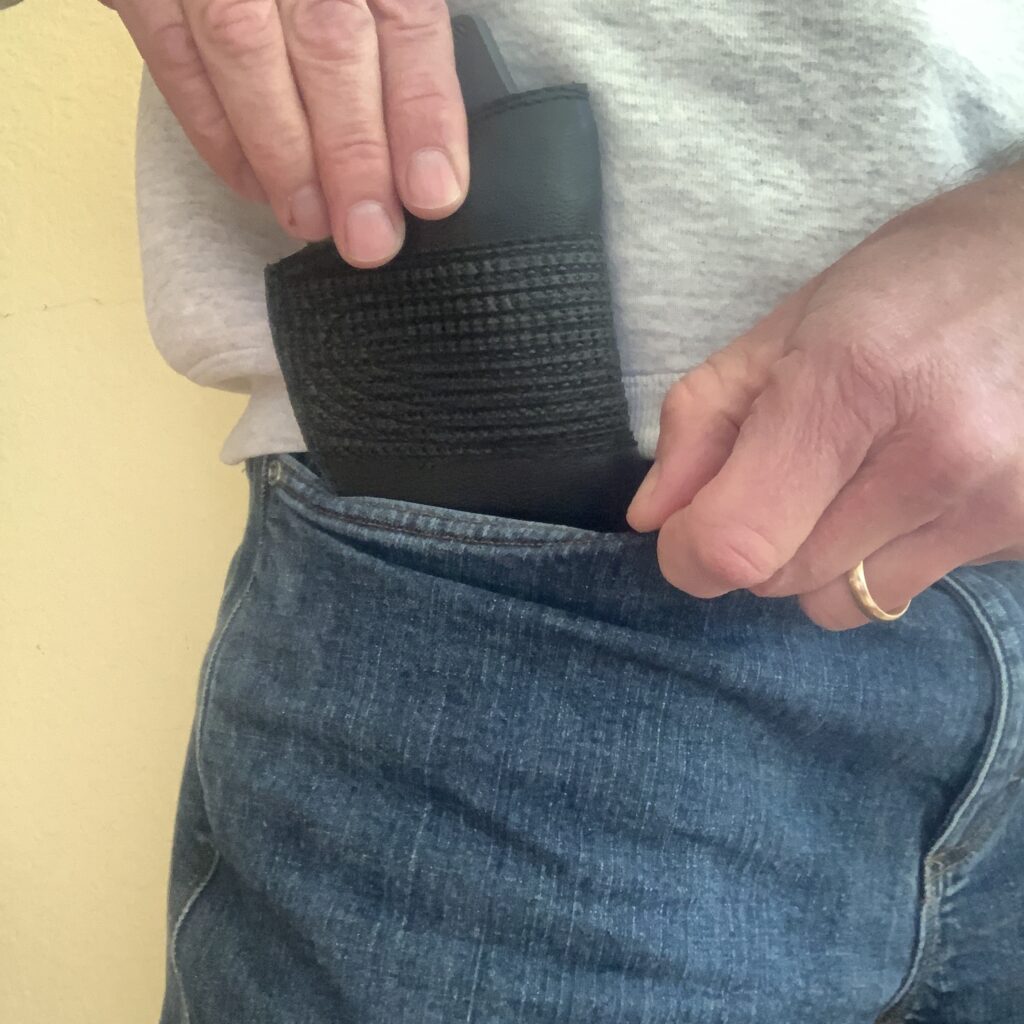
Get your finger off the trigger and place it high up on the frame or cylinder, away from the trigger guard. If you have an external hammer gun, place your thumb on the spur to sense and block its rearward motion (and stop immediately, if you feel it start to move as you holster, because something is probably pressing on the trigger).
Move the gun into the pocket and towards the holster mouth in a manner that the muzzle is not pointing inwards, towards your body, but rather is pointing parallel to the surface of your body, with your muzzle clear of anything that you don’t want to shoot. A helpful method to accomplish this is to use your fingertips (or your thumb, if it’s not riding an external hammer) to create some standoff between your body and your gun as it penetrates into the pocket.
Assuming you’re standing, and the gun is carried in a front pocket, another helpful tip to avoid muzzling yourself in this scenario is to take a step back with the leg that has the holster in it, to straighten the leg and keep the holster parallel to its surface. Should anything go wrong, and you accidentally fire a round while holstering, this may prevent you from shooting your leg, knee, or foot.
Again, if time and circumstances permit, remove the pocket holster from your pocket before you return your gun to it—it’s just safer that way.
Summary
I think I’ve hit on most everything that I wanted to address about pocket carry, but if I forgot something, I’m sure we’ll clean it up in the comments.
The biggest thing to remember about pocket carry is that it requires dedicated practice, because it’s different than carrying your gun on the belt. If you plan on using this method, make sure you put in the work to be efficient and safe with the mechanics of it.
As always, keep your head on a swivel and be safe out there!
*****
Recommended Sources
The Wilderness (“Wilderness Tactical”)
endnotes
1. The sole exception that I make to the rule of not placing anything else in the pocket that contains the holstered gun, is a reload for it. If I’m carrying a gun in my right front pocket, I sometimes place a Speed Strip behind the pocket holster, which prevents it from printing through the pocket, protects the ammo from getting damaged, and keeps it accessible to my strong hand. If I have another spot that I can carry the strip (a coin pocket, or a thigh pocket, for example), then it will go there instead, but if my wardrobe limits my choices (i.e., dress pants), then I’ll put it in the strong side pocket with the gun. Since the loaded strip settles to the bottom of the pocket, it shouldn’t normally interfere with getting a good grip on the gun. Outside of the occasional reload, though, everything else is kept out of the pocket carrying the holstered gun;
2. Please note that I said the gun-holster fit should be “relatively tight.” We don’t necessarily need the gun to fit so tightly that you can hold the holster upside down without the gun falling out, because the pocket itself will work with the holster to keep the gun in place during normal activity. However, what you don’t want is a fit that is so loose that the gun may slide out of its holster when you’re sitting down, running, falling, etc. If the gun is too loose in the holster, it could become unholstered inside a roomy pocket and rotate unpredictably. In a pocket with a large opening, the gun could even slip out, so we want a reasonable level of retention from the holster (considering the type of clothing being worn) to prevent these things, but the gun doesn’t have to go in and out of the holster with a positive “click;”
3. I’m not a fashion adviser by any stretch of the imagination, but your selection of clothing is an important part of this calculation, as well. Clothing made of thicker, more durable materials will do a better job of concealing a pocket holster than clothing made of thin materials, because it does a better job of supporting the weight of the holster-gun combo, and won’t allow it to print as much. Also, for obvious reasons, tight-fitting clothing will make it more difficult to successfully hide and access a holstered gun in your pocket. So, while paying attention to the size and shape of the pocket is critical, there are other clothing issues to be thinking about, too. Hey, do these stripes make my gun look fat?

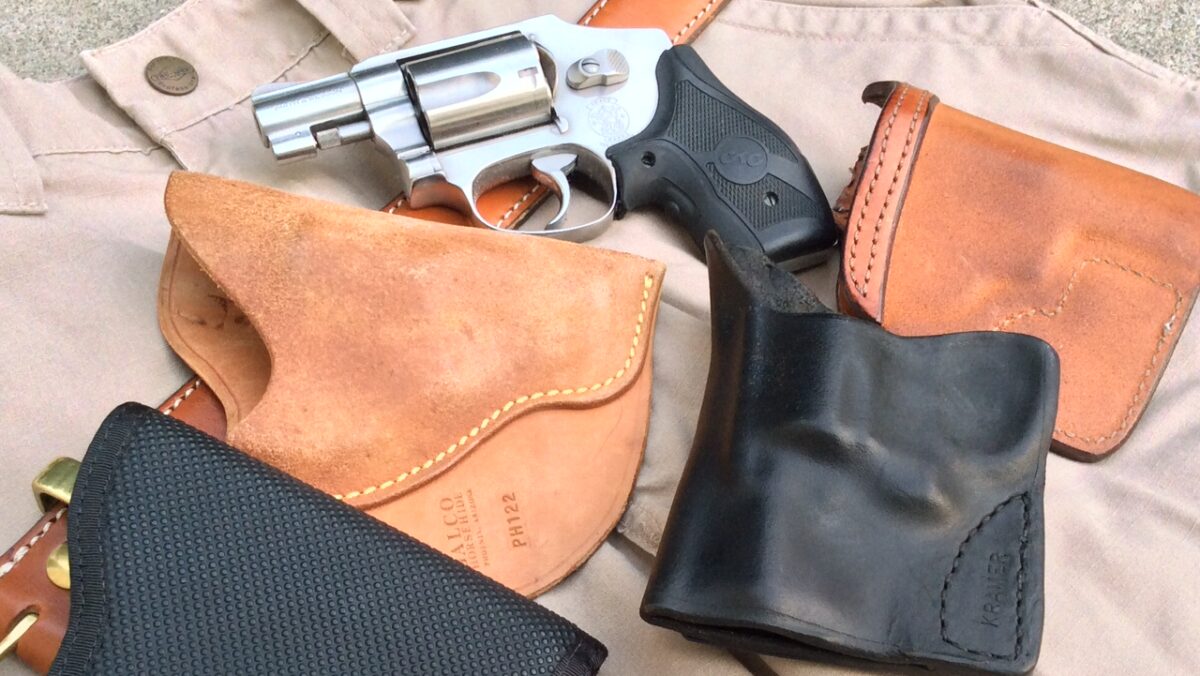
This article really nails the pocket holster topic, and the pros and cons. The one downside for me, as Mike points out, is accessing the snubby when sitting down. Still, for over the last year my Simply Rugged pocket holster is the only holster I’ve used. My belt holsters (I own more than one handgun) are there in case I decide to take a really long hike in the woods and might encounter a bear or troglodyte.
The Simply Rugged pocket holster fits in all my jeans pockets and, as the name suggests, it’s tough. I regularly walk several miles almost daily carrying my air-weight snub in the pocket holster and don’t even notice it.
Another plug for Simply Rugged’s pocket holster: its amorphous shape prevents the snubby from printing. In my front jeans pocket it looks no different than the other pocket because of all the junk I usually carry.
Thanks Spencer, I appreciate the testimony of how pocket carry has worked for you. I agree that Rob makes a great pocket holster! It’s my favorite, these days.
Great article very informative loved it.
Thank you Sir! Welcome aboard!
Great article. I’ve bought a couple of pocket holsters from Mika’s. Excellent quality and the fit in front or rear pockets is just great. I carry in the back pocket while out mowing. You just never know these days.
Chris
Thanks Chris, I think you’re right. You just never know . . .
Mika’s does great work. Can’t go wrong with them.
Salient points well stated !! When handling and carrying the gun in one’s pocket, (1) keep the booger hook off the bang button until you want it to go bang, and probably more important – (2) keep other ‘stuff’ away from the bang button ! The techniques pointed out are all too frequently overlooked. Mike, you did a great job of breaking things down into detail, and then explaining the how and why. There can’t be too much emphasis on practice accessing and reholstering your pocket gun (yes, when empty). Repetition builds muscle memory so things become reflexive.
Far too many folks use the Mongo system: Uhhh, gun . . uhhh, holster . . uhh, pocket . . Mongo all set.
One other carry location that I’ve found particularly useful is the inside pocket of a casual vest such as can be found at Bass Pro Shop or Cabela’s. They have an interesting selection of casual vests that make folks wonder whether you’re addicted to fishing or an avid photographer ( I stick some swag pins on to throw diversions). If you find one in colors other than Shoot Me First Khaki or Black, then it tends to blend in much better. I have Sam Andrews’ excellent pocket holsters that are nicely boned to the contours of a J-Frame. It fits nice and snug in the vest pocket, but not so snug that I can’t easily remove it.
Sitting in a vehicle, you can easily reach what is now your primary for any nare-do-numbskull that walks up to your vehicle, such as at a drive through ATM for example. Nothing says ‘I don’t love you’ like seeing five wadcutters staring at you. In restaurants, or any other public venue, when you’re seated, the inside vest pocket can more quickly be accessed than pants pocket, or even IWB holsters in some situations. More often than not, if I’m getting negative vibes about certain creatures in public, I can fold my arms as in deep thought and distraction and have my shooting hand on my J-frame and no one is the wiser.
Thank you Sir, for the great explanation of your vest pocket carry system. With that method, you’ve got all the positives of a shoulder holster (seated access, surreptitious draw) without the negatives (increased comfort, the ability to remove your vest if you get warm, etc.). Sounds like a great way to do business.
When you’re in deep thought, the thugs are in deep trouble. ; ^ )
In my experience, molding tightly to the gun can be more of a liability than an asset. after a period of using a Pocket Concealment System leather N-See-Um (straight) holster for a S&W Centennial, I decided that a looser fit reduces the risk of the holster following the gun out of the pocket and went over to Tuff Products’ Jr Roo. At that, I noticed that day in/day out use of the same holster molded it tighter than I prefer. As a result, as I’ve posted on my website:
“If you prefer a soft pocket holster – such as the DeSantis Nemesis or the Tuff Products Jr. Roo – it’s a good idea to avail yourself of the low price and get more than one, then alternate holsters at least once a week. Especially with revolvers, if you allow constant use to mold the holster to the gun, you will increase the likelihood of drawing the holster with the gun.”
Personally, I alternate a couple of Jr. Roos on a daily basis.
Thanks Stephen, that’s valuable feedback, and I appreciate you sharing it with everyone. There’s definitely a balance that has to be achieved. If the fit is too tight, it can indeed interfere with the draw, or lead to the holster coming out with the gun. That’s obviously too much of a good thing. Your rotation plan is a clever way to minimize that risk.
RevolverGuy readers who haven’t visited Stephen’s site will find lots to enjoy there. Make sure to download his valuable book, Defensive Use of Firearms, as well. Stephen offers a free download on his site.
Good article on a good discreet carry method… I rarely use it (my revolvers tend to three plus inch barrels) and I’m pretty rigid about all the other crud I keep in which pocket. Might be a little OCD. Winter coats though, I do. I just wanted to add another reason for a pocket holster: protecting your clothing from the gun. If there’s a layer between the hard edges and the pocket you won’t get holes you didn’t want. I’ve regretfully thrown out favorite items of apparel more than once and I’m sure others have as well. Small price to pay vice personal safety, but still…
That’s a great point that I didn’t make. Thanks for adding it, Riley!
The biggest challenge for me with pocket carry is finding a place for all my stuff. I’m like you, and I like to keep things consistent. It bothers me if I have to leave something behind, or carry it in a new spot. Cargo shorts or pants are a savior with pocket carry. It’s a lot tougher in jeans, for me. I make it work with them, but usually have to leave some things behind.
I love pocket carry. With how hot and humid it gets here (KY) in the late Spring and all Summer, pocket carry is the only reliable way for me to consistently carry.
I am a fan of Mika’s Pocket Holsters. I have one for my snubnosed S&W Model 12, as well as my Taurus 856. However, I use a Galco StukOn-U for my S&W 642, which is what I carry the vast majority of the time. It lacks the handmade feel of a Mika holster, but I think it’s a good holster.
Great recommendations Axel, thanks!
Awesome article! Well covered on the pros and cons of pocket carry. While Ive been carrying a snub revolver pocket carry for over 30 years I found this article informative, interesting, and you mentioned things that I didn’t think of. Thanks for sharing this with us.
Thank you Sir! Great to see you here in the comments. I look forward to seeing you at the Roundup again later this year. I’m hoping to catch DB’s class on pocket carry, since I missed it last year.
I pocket carry a K6s 2”. Before that it was a Taurus 85, which I drew with thumb over the hammer. I have drawn and shot the Kimber twice from my pocket, both times at a Copperheads on our farm. I use the same Simply Rugged holster for a Bond Arms Roughneck. Used that once this year on a Copperhead but the pocket holster and gun were in…my garden basket 🙂
As for things in pockets: I dress up for town. Older dudes can do that without sticking out in the sea of American casual.
I wear a sports coat and chinos to work. The coat is my “man purse,” for wallet, phone, and keys, so my right pocket can haul the holster and gun without hindrance. They do not print in chinos.
That sounds like a great system, Wheelgunner!
Regarding access while seated (specifically while driving), I’ve been following Darryl Bolke’s recommendation and removing the entire holster from my pocket, then placing it under my opposite leg.
It’s still hidden from view, and it’s quick to access if I should need it. Otherwise I put it back in my pocket before I get out of the vehicle.
Admittedly this doesn’t apply to other seated positions like chairs and desks, but those are also more often situations where it’s easy to stand up unlike a car, so accessing something in the appendix position becomes my go-to (because the best speedloader is a second revolver)
Thanks Kris, I’ve occasionally done the same thing for many years, but it always makes me a little nervous to be honest. It’s OK if I’m parked and not going anywhere, but I don’t like to store the gun under my leg when I’m actively driving. Everything is great until cars start braking hard, maneuvering aggressively, or (Heaven forbid) crashing. I’m reminded of two agents in the FBI Miami shooting who lost their guns that way.
I’m not a fan of regularly carrying a gun in the center console or glovebox, but on days when I’m pocket carrying and driving, I’m much more likely to transfer the holstered gun to the locker underneath my car’s center armrest. It’s got a latched door to keep it in there, and I think it’s less likely to go flying off into the unknown. I can lift my arm off the rest, open the door, and get to it quickly enough (for the most likely driving scenarios) if I need to. It gives me more peace of mind than putting the gun under my thigh.
I think an advantage of a Desantis Nemesis and similar holsters are you can relocate them to inside the waistband for those scenarios. It is not something I would normally do walking around, but while seated in a car or on the couch at home, I find it useful.
Like you, I keep my gun pocket empty except for the gun a speed strip and a Spyderco Delica 4 clipped as far back in the pocket as it can go. As a type one diabetic, pocket real estate is at a premium.
Thanks for the excellent article, as always.
That’s a good workaround too, Chris! They’ll certainly do as an impromptu IWB holster if you’re sitting. 10-4 on the real estate issue. I wish I could make my Spyderco Endura work at the rear edge of my pocket like that, but it always gets in the way when I use a pocket holster, and I have to find another place for it (usually a cargo pocket, if I’m wearing those clothes), or ditch it entirely (if I’m in dress clothes).
You make a decent point about having it under the leg, and checking DB’s more recent writings it looks like he’s also moved away from it in favor of clipping the snub inside his waistband while driving.
Since I have a hook panel for my Hamre Hook grips laying around here somewhere, I plan on trying the same, or just leaving it in my pocket and relying on my appendix option when I have both on me.
That’s even better than stowing it in a compartment. Keeping it on you would be preferred, in case you have to leave the vehicle in a hurry. It’s an interesting use case for the hooked grip, that I hadn’t considered. I just received a sample of the Hamre Hook grip to work with, and I’ll give it a try. Thanks for the idea!
Without a pocket holster, that used to be common practice among off-duty LASD deputies, while driving. You may recall, however, that placing the unholstered did not work well for what I recall as two FBI agents, back in April 1986, in Dade County FL; the impact off ramming the suspect vehicle flung those guns to the floor of the vehicle.
Beretta 21A 22LR in a Desantis Trickster. Fits in my pants or jacket pocket. Plus, it fits nicely in the cell phone pocket of my laptop bag.
The other downside of pocket carry is that it is extremely difficult to facilitate the drawstroke with the support side hand. If this is a primary carry, it may be advisable to consider a second gun in the support side pocket or as I have found very beneficial, the ankle holster. 🇺🇸👮🏻♂️👍🏻
An outstanding observation, Duncan. I should have mentioned that myself, but I’m fortunate to have sharp readers playing clean up for me. Thanks!
Thanks! 🇺🇸👮🏻♂️👍🏻
Great article Mike. I’ve been using a Mika pocket holster since 1989. I use it mostly in the summer with cargo shorts, but sometimes in other seasons with trousers having comparable pockets. I was carrying a Colt Agent with a spurless hammer, but have switched to a Kimber K6xs, just have to be sure the rubber grips work well with the trousers Pocket.
Hi Bill, great to see you here! The rubber grips can indeed be a challenge sometimes. It looks like the K6xs grip is proud at both heel and toe, so you’ll need a generous pocket. The K6xs will be a great replacement for your spurless Agent though—it will be nice to save a little wear and tear on that irreplaceable Colt.
RevolverGuys who do social media on Foxtrot Bravo should follow Bill’s work at The Firing Pen—LOTS of great revolver stuff there!
The arrival of my infant son was the cause of my complete and total conversion to pocket carry. A baby carrier that straps across the hips means no belt holsters, constantly rolling around on the floor is much easier with an airweight j frame in the pocket than with a big chunk of metal on my hip, and now that he’s walking and his head is the same height as my waist and he gets into everything …you see where I’m going with this. Pocket carry rules and a J frame in the pocket works for every season.
What a great way to solve the problem! Thanks for sharing that Andrew, very insightful.
I was talking to a new father recently about belt holster selection, and emphasizing how important it was to have proper retention qualities and trigger guard coverage when he’s gonna be lifting, holding, and wrestling with his young son. We didn’t talk about pocket carry as an alternative, but probably should have. I’ll fix that.
Andrew,
I was in the same boat. Striker fired bottom feeder pistols and wrangling small kids don’t mix well. I made the switch to a pocket j frame when our first child arrived and never went back. Our “baby” is now 8 and still loves to climb up on my lap to “drive” the tractor. Pocket revolvers are a good risk mitigation strategy.
Y’know… the whole rigidity thing comes up again for me in that I generally belt carry (be it appendix or OWB) and put speedloaders, strips, etc on the belt as well. Small knife accessible by either hand. All the fighting stuff in the same place, on the belt. Pockets free for daily dailies. Never really thought about it before in this light. Mike your article is thought provoking for me- thank you! Also, for safe reholstering, thumb on hammer is good, but I also will put my finger behind the trigger so I can feel if some foreign thing is inside the trigger guard pushing the trigger to the rear.
Finger behind the trigger—another great technique for DA and (especially) DAO revolvers. Thanks again for the assist!
My edc is a pinned barrel mod 60 38spl, she’s been around a while. 80% of the time it’s in a DeSantis 02 in my left pocket. The other time is in a 1791 IWB. I ditched the boot grips for an Ergo some time ago and it makes it just disappear. I get a full firing grip and other aiming advantages. Being left handed requires a change of hand for reload and I use a 7rnd speed strip in 2 1 2 configuration. Works great. I have been experimenting with the zeta6 jclip, work in progress. Can’t use the small jeans pocket for storage, my time piece is always in there. Great article keep up the fight
Thanks Rick. That ERGO grip is an interesting design. I’ve handled one, but never shot with it. You’re the first actual user that I’ve encountered, so I’m curious to ask more about your experience with it. When you first started using it, did you have to focus on setting your wrist at the proper angle (rolling it forward) to make the sights line up right, or did it just naturally happen? How does the grip handle in recoil? What kind of loads are you shooting in that 60 with the ERGO grip?
Mike, I was surprised to realize you’d never written about the pocket carry method, but I’m so glad you resolved that oversight with this excellent article. I pocket carry a S&W 642 routinely, whether in the right pocket as a primary or in the left as a BUG. I find its light weight and two-finger grip essential to effective concealment. I alternate holsters – square-bottomed Simply Rugged and DeSantis or round-bottomed Mika and AHolster – as my wardrobe dictates. Unlike the others, the rigid Kydex AHolster Backbone is comfortable only in the pocket it’s shaped for. FWIW The AHolster Bactrian is the only pocket carrier for speedloaders I’ve encountered and it’s slim and quick. Most of the time I satisfied with a speedstrip carried upright in a Simply Rugged Pocket Mag Pouch. As you mentioned, it’s easy to run out of room for all our other stuff, but I find that a No.4 Basic Pocket Mag Pouch from The Wilderness organizes my OC, small light, and folder quite neatly. Finally, while I mostly carry in trouser pockets, a pocket holster is a boon for carrying in a jacket pocket when belted in the car or when wearing a heavy coat in cold weather. Yes, my pockets look a little lumpy (just like the rest of me I suppose) but having all the pocket carry advantages on tap nearly everywhere I go is worth it. Thanks again for an informative and well-written piece. Michaelb
Thanks Michael, I appreciate the shout-outs to the other makers that I’m not experienced with, like AHolster–I’ve seen their gear advertised, but have never used any of it, so it’s helpful to hear from someone who has. The RevolverGuy audience is a great resource to tap into!
I’ve carried an LCR in a pocket holster for years. The holster I recommend is the Recluse. It is open to the inside and full coverage on the outside. The trigger and guard are nestled in a firm rubber molding attached to the leather. The print does not look like a gun.
The draw is as follows, your fingers go between the leather and the grip, the gun tips inward and releases from the molding, then pull the gun out. The holster stays in your pocket.
My grips are Hogue Bantams. They are small and adequate. It is not comfortable to shoot all day but I can hit with one hand. Two hands is even better
I wear normal jeans. I recommend Recluse Holsters very highly. I’ve bought 3 of them over the years
Thanks Brett, I’ve not used one of those, and appreciate you sharing your experience with them!
Several yeas ago, I had knee problems and walked to my Mailbox to retrieve the daily mail. As i turned to walk back to my house some 300 feet away, and old Dotson pickup came down the road with 3 25ish men in it. I had already sped up my pace to the house when the backed up and pulled in the drive. My hair on my neck told me I was in real trouble. a 70 Y O with physical diminished capabilities could not run or get away from them. The driver slammed the truck in park and came out toward me and asked me, in aa very harsh way for work. I live in the country. Told him I had no work while the other guy was getting out and headed, aggressively, toward me also. Third guy was laughing uncontrollably during the whole incident.
Long story short, the driver was close now and had drawn his arms to waist lever making fists with a scowl on his face, and both were closing fast. Put my hand up, after telling them nicely I had no work for them, and with a commanding voice told them to stop coming and get back in their truck. Driver never stopped so I dropped my mail and slightly bent my knees and reached my hand in my pocket and grasp the 7 shot Taurus 357 snubby which I had in a modified DeSantis pocket holster and started to draw it. The first guy was still coming but the second guy told him, “Common Bobby, It aint worth getting shot over.” After taking another 2 steps, driver stopped and spit at me, cussed me, kicked the grass, and turned to return to his buddy and leave. I was 71 Y O, had a seriously bad knee which I have sense had replacement, and had 2 punks ready to beat me to a pulp in my yard who had gotten between me and my house. I was glad to have the revolver in my pocket and thanked God they turned and left.
Incidentally, the drove 5 miles from my house and found a neighbor doing the same thing then beat him and left him in a pool of blood. His son told me he died after a 3 week stay in the hospital and being home for another 3 days. He was legally blind, only had prefrail vision, and was 85 Y O.
My biggest mistake was not calling the Sherriff and reporting my incident until after I heard of his beating. If I had called maybe my neighbor would not have been beaten. Guys my advice, call 911 and report any incident of violence. Just may save someone else. Sorry for the long story Mike but hope it might help someone in the future.
Pop Pop, it’s good to hear from you again, and I hope you’re doing well.
I’m sorry you had that experience but I’m glad you were prepared for it. There’s all kinds of evil in the world, and we never know when we’ll run into it. Your cautionary tale is a good reminder for all of us.
To each his own, I guess. What works for me is a 442, with Delta Grip, in a Desantis pocket holster, and cargo pants. The Benchmade, Mini-Grip, keys, and small light, go in the left side pocket, with extra rounds in a speed-strip,
In the lower right-side cargo pocket.
The only down-side (a big one) is drawing while seated. I’ve carried them all, big and small, but as I get older, less is more.
Interesting, you didn’t mention much about grip selection.
Regards,
Bob
Thanks Bob, you’re right—I mentioned the grip issue in a few of the photo captions, but didn’t spend much ink on it in the body of the article. It’s an important piece of the puzzle, and deserves more discussion, but I was already running long and didn’t want to stretch things out more.
I see lots of snubs with grips that are too big to be practical for pocket carry (or ankle carry, for that matter). The long grips that allow three fingers on the front strap, below the guard, are wonderful for shooting, but don’t work very well for carrying guns in tight spots. This is why all of my carry snubs have boot grip-style grips that are flush with the bottom of the frame. They’re not as easy to shoot as guns with the oversized grips, but they work well in pockets and on ankles, which is the primary mission for a small frame snub in my little world.
Frankly, if I’m going to carry on the belt, then I can usually pack a bigger gun than a small frame snub, and can afford to have a bigger grip on it too. I discussed this a bit in my piece on the Compact Service Revolver, a while back. Please understand, I don’t have any problem with folks who prefer to carry a small frame snub on the belt, but it’s just not something I do a lot, so my snubs wear small boot grips.
There are some pockets that are big enough to make the larger grips work, and if you wear clothes like that, you can certainly enjoy the benefits of a bigger grip. No reason not to. Same for people who primarily belt carry their snubs.
Aside from size, there’s also the matter of materials. I find that wood, G10, and hard rubber/plastic grips work better in a pocket than soft rubber grips. Again, the soft rubber ones are great for shooting, but less friendly in pockets (and on ankles). Those OEM Hogue Tamer grips on the Ruger LCR that you see in the photos are an example of that, I think—a little too long, and a little too soft to be a great choice for a pocket gun in the clothes I normally wear. Unfortunately, the Hogue Bantam Boot grips present the opposite problem for me—they’re a little too short for my hand to give me the control I want while shooting the gun. There’s probably a “Goldilocks grip” out there for the LCR that will be just right for me, but I haven’t found it yet. The Hogue G10 Extreme grips are nice, but still a little long for my taste. The short-lived Lyman-Pachmayr G10 grips were much the same—comfortable, but still a tad long, with their three-finger (two and a half?) design. Same for the Crimson Trace LG-415 (I really wish they made a LG-405 for the LCR—that would be perfect).
This seems like fertile ground for someone to come up with a winning LCR boot grip design. Hey, VZ Grips, are you listening?
Anyhow, I’m talking too much again. Thanks for your comment, be safe.
The SchluderShots website has one of the old Crimson Trace 2-finger LCR grips for sale at the moment, listed under LCR 22.
Have you tried the Hamre Forge grips for the LCR? They’re easily my favorite, though mine is only in .22LR so I can’t speak to recoil. You could always build them up with some tape if you want some more padding, like GoonTape or 3M Friction Tape. That also works to make rubber grips less tacky against clothing, something Harry’s Holsters has talked about on their youtube channel.
My Hogue Bantam Boot grip always felt too small and slippery, and it wasn’t hard to pull the gun out of my hand even when I wasn’t sweaty. As an experiment I used a few layers of gaffer tape on the bottom of the backstrap to build up a rear palm swell, then wrapped it in one layer of friction tape to keep it in place and provide more traction.
Between those two things it stayed in place much more solidly, but still offered the rubber cushion for the web of my hand.
By that time I already had a Hamre Hook that I’m perfectly pleased with, so I haven’t really used the taped up Bantam Boot, but I just wanted to throw it out there as a possibility.
Kris, thanks for the great info and the steer to that website, which I was not familiar with. What a great resource!
Funny you mention the Hamre grip, as I just installed one on my LCR last night. I’ll be working with it in the weeks to come for a review here at RevolverGuy. I’m impressed with what I’m seeing so far.
I’m too big around the middle and have yet to find a holster that fits comfortably. I know it not supposed to be comfortable but comforting (did Ken Hawkathorn says that?) but the only way I have carried for around 10 years is in my pocket. Both snubs and baby autos work for me. And in your list of holster makers Rob at Simply Rugged makes a wonderful and cost effective product. If not his stuff I use Kramer with the polymer flap to hide the outline. For hiking I like the safepacker but it will be attached to my belt. I’ll keep looking for that perfect IWB holster while carrying in my pocket.
Hey, if it works Bill, why change it? Just curious—have you considered trying one of Rob’s Sourdough Pancake holsters? Maybe an OWB holster would work well for you, if you’re having problems trying to find a comfortable IWB solution?
Hi Mike,
First, it was a pleasure to meet you at the last Roundup and “Good Lord willing and the creek don’t rise” see you again at the next.
Very informative article along with great follow-up comments…thanks to all. I have been giving consideration into pocket carry for a while now and this will help me in making selections.
..and unfortunately, there was an example of pocket carry “done wrong” in Albuquerque a couple of days ago. By fractions of an inch and the grace of God, preliminary reports are that the person struck was not too seriously injured.
Be well!
Wayne, it’s great to hear from you, and I appreciate your kind words about the article. I’m glad that it, and the comments from our excellent readers, have been helpful!
I didn’t get to attend Darryl’s pocket holster class at the Roundup, but it was excellent, by all accounts. That will be a priority for me next year, and I think you’d enjoy it too—hope to see you in that one, or one of the other great classes on the schedule.
Please check back and let us know how your new pocket holster journey works out. If you have any questions, just drop me a line at mike@revolverguy.com
Great article Mike. It reminds me that I need to give pocket carry another try. It didn’t work out well for me before, but I think it was a holster selection issue. I will try different holsters based on your recommendations and see how it goes because I do want the option.
In the first picture in the Tactical Advantages section it appears that you may have a touch of “J frame thumb” healing up. I could easily cure my “JFT” but I’m not willing to give up my 642’s 😉
Sharp eye, Derek! That’s exactly what it is! I’ve melted the edges on all my cylinder latches, but they still bite me. It’s probably time for some more radical surgery on them. I think the old flat latch design would probably be a better part for S&W to use.
Good luck with the second try. Hopefully a better holster will do the trick for you this time. Let us know how it goes.
Hi Mike, I like your articles and revolvers as well. Regarding holster retention, your first picture in the article shows an easy solution on two of the holsters i.e. they have a button hole at the top. Its easy to put one into either a soft, quickly dries, nylon holster or leather holster, locate the holster in your best location on each pair of pants and mark the pocket liner and then stitch in an appropriately sized button making daily consistent carry much easier. Also thin plastic binders i.e. 1/32 to 1/16 thick are easy to cut out into a rectangular cell or wallet shape or circular skoal can shape and stitch along the bottom edge of the same holster to make a false outline that masks the handgun’s outline in the holster. Keep up the good work!
Thank you for the kind comments and the excellent suggestions, Sir! Much appreciated!
I have Glocks and a 1911, as well as an assortment of K,L and N frames. But my most trusted carry gun is my little J frame 342, in .38 +p only. Why? Because it’s comfortable to carry, in all manner of attire, so I carry it. Which I think is an often overlooked consideration. Anyway, I usually use a simple Galco pancake holster. But there are times when my Kramer pocket holster is a better idea. It’s a great holster. But I do have to be mindful of the style of pocket I use it in, otherwise the revolver may be drawn still wearing its holster. Thanks for the article Mike. You wrote a very thorough piece on a subject that doesn’t get much ink.
Thanks Doug, I appreciate the kind words! Walt Rauch used to say that most pistoleros, “talked .45s, shot 9mms, and carried .38s,” and I think you explained just why—they’re convenient and comfortable!
The Kramer is the holster that got me started with that “wiping” technique I described in the article. It’s a wonderful holster, artfully crafted, but it is easy to miss the hook in some pockets. The “wipe” solved the issue for me.
Mike, thank you for a very in depth and informative article regarding pocket carry. The prior 55 comments from your readers also provided a wealth of insight as well. Ladies and gentlemen, please accept my appreciation for sharing your experiences with this mode of carry.
I have a leather Don Hume pocket holster for the past couple of decades. It works well for my S&W 642 with a 2 1/2″ barrel. I use two sets of handgrips: Pachmayr grips for the winter, and S&W three finger synthetic grips for the summer. The more svelte S&W grips clearly enhance pocket carry. However, I used my Don Hume holster with my Pachmayr equipped 642 just last week.
I was bundled up for a 150 mile motorcycle ride in 32 F weather and couldn’t easily reach my revolver under all those layers. My law enforcement motorcycle club utilizes a vest with multiple interior pockets and that’s where I stored my S&W. Dropped a speed loader in the front right pocket to back up an ammo pouch on my belt and I was good to go! I probably didn’t need several reloads since my band of off-duty / retired brothers were equipped with enough firepower to render assistance to any on-duty LEO, if needed.
My leather pocket holster seems to be ambi-dexterous. I’m not sure if others mentioned this, but when I performed uniform patrol, my back up revolver (S&W Model 36) resided in my left hand (non-dominant) jacket pocket. God forbid my dominant hand was immobilized or severely injured, I still had five rounds available with my left hand. To this day I still practice shooting with my weak hand supported and unsupported. Some habits are hard to break.
The good habits like that shouldn’t be broken!
I honestly didn’t expect such an outpouring of interest in this article, but I’m grateful for all the comments and observations. Anyone looking to learn about this mode of carry would be wise to read and heed all these comments from experienced pocket carriers. There’s much to learn from this crowd!
I knew you were a tough guy, but riding motorcycles at freezing temps confirms it! I’m glad to hear you’ve got such a great crowd to ride with!
Opa,
Every time I’m in a uniform coat, my left hand can grab a backup out of a pocket! Glad to hear it’s not just me! Our three season does not have inside pockets, so which pocket depends on which coat, but otherwise…
I’ve been pocket carrying about 15 years. I also started when I had small children to carry. The Kahr PM series have worked very well for me, as have a 642, an LCR .38 with an Ergo Delta grip, and currently an LCR .327 loaded with .32 Mags.
The funky-looking Delta grip works well in the pocket, sights align naturally for me, you get a good full grip, but it is a tad thin in the back strap and you can feel that while firing. Less fun for practice, just fine if needed.
I thought the Bantam Boot grip would be great on the .32 LCR. It does work well in the pocket and it certainly LOOKS cool, but a rushed draw ends up a little low on the grip and feels insecure. When I eventually dropped the gun while smacking the ejector rod during a reload on the clock in an IDPA match, that clinched it. I next tried the Rogers Enhanced, but it was just too long for pocket use.
I’ve found that, despite my doubts, the rubber Hogue the .327 LCR shipped with works just fine for me in pocket carry. That is in my pocket as I type this.
Ben, thanks for the helpful info, and especially for your thoughts on that unique ERGO grip. I couldn’t warm up to the Bantam Boot myself, and prefer the regular Tamer grip with finger grooves, as you do.
I have used the Remora holsters,one of the first sticky kind. Not too pricey and work fine. Great article Mike
I wish some one would remake the original style of Roy’s pancake holsters, all the imitators have missed the mark, trying to improve what did not need improvement MTC
Old curmudgeon
I have been very pleased with my Barsony Leather pocket holster I got off of eBay.
It is just SO convenient to pocket carry.
If I am going on a long car trip I switch to my belt holster (a very nice paddle holster from A. E. Nelson Leather Co.) but I would say 90% of the time it’s stubby in right pocket, a speed loader and pocket knife in the left, wallet in the back and I am good to go.
I can reach for items on the top shelf on the store without worrying the bottom of my holster is showing.
I have practiced my “lobster claw to finger gun” draw so many times I don’t have to think about it.
However I still make a point to slow down and think about it, be deliberate in what I am doing.
Great and well thought out article.
I’ve been a fan of pocket carrying a M&P 340 and P3AT for awhile, in the often “poo poo-ed” Sticky Holster. They have lasted several years and I’ve not had an issue.
Thanks Tim, glad you enjoyed it. The Sticky Holster would make a fine pocket holster!
Another Aholster user here. LCR9 with the small Lasergrips. I’ve found the Aholster has the most aggressive hook; it really tends to stay in the pocket. Downside is that it can wear a hole in the pocket itself, depending on material.
This combination is commonly my primary hot weather carry but can also serve as backup to a Glock 19. Ammo commonality is nice, and thumbing rounds out of a bottomfeeder mag is surprisingly quick once the moonclipped 5 are ejected.
Thanks Dave, that’s good testimony for the Aholster product. Yep, a pistol mag makes a handy revolver loader!
I started carrying this last year (Sig P365). With the holster class I took, I used a paddle holster, and subsequently practiced with IWB. I purchased an Alabama pocket holster, but every practice draw, the whole thing came out and I thought it was mostly useless. Your tip to “draw like you’re wiping the bottom of the grip” made the Alabama holster a clean draw every time- gym shorts, chinos, jeans- all worked perfectly. My regular carry is an Sig P365, but just purchased a Ruger LCR and will be purchasing another Kydex Alabama holster. Great article!
Glad the technique worked so well for you, Anthony. I think you’ll find the LCR is a better pocket gun, and the P365 will work better on the belt. Be safe!